There are millions of insect species in the world, yet butterflies are some of the most popular. Butterflies are found all over the world, some in rare tropical areas and others flitting around your backyard.
The Life Cycle of a Butterfly
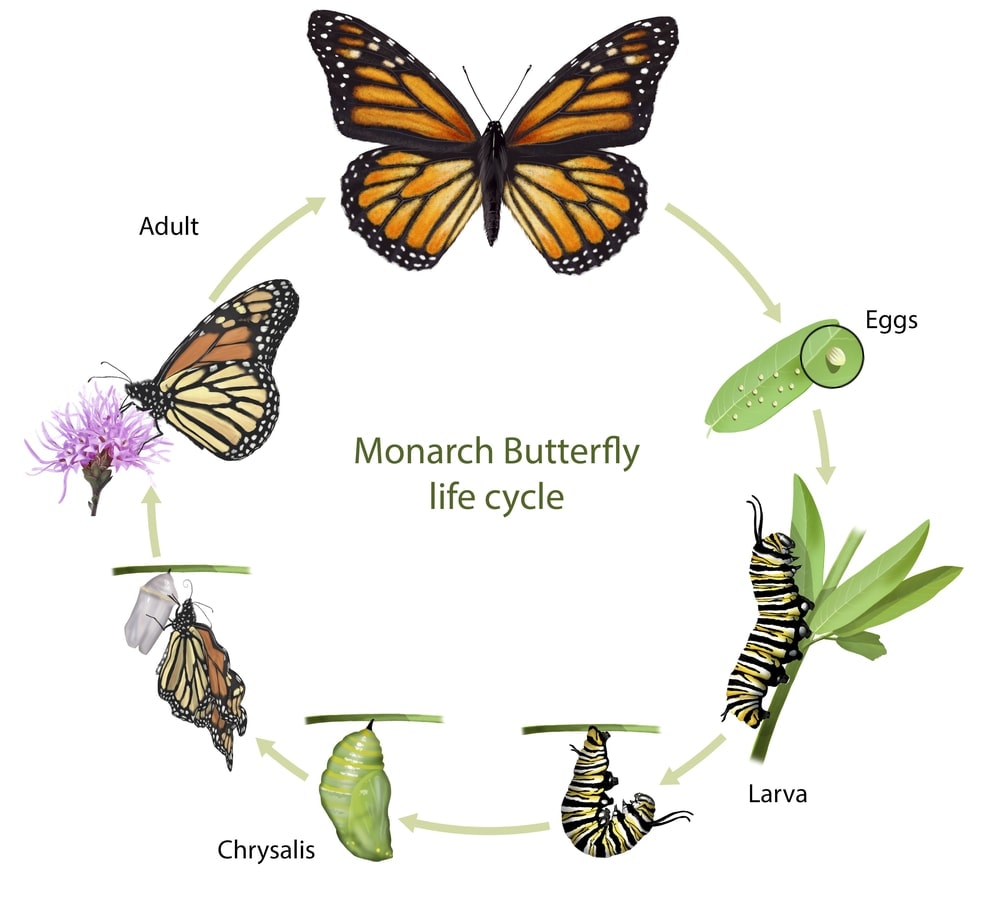
The butterfly and the moth share similar lifestyle processes. Their life cycle is called metamorphosis. It comes from ancient Greek words that combine to mean a transformation in shape.
There are two types of metamorphosis that an insect can have. Insects like crickets, dragonflies and cockroaches experience incomplete metamorphosis. We focus on complete metamorphosis since all butterflies and moths will have this variety. There are four stages in this process, laid out below.
I. Butterfly Life Cycle – Egg
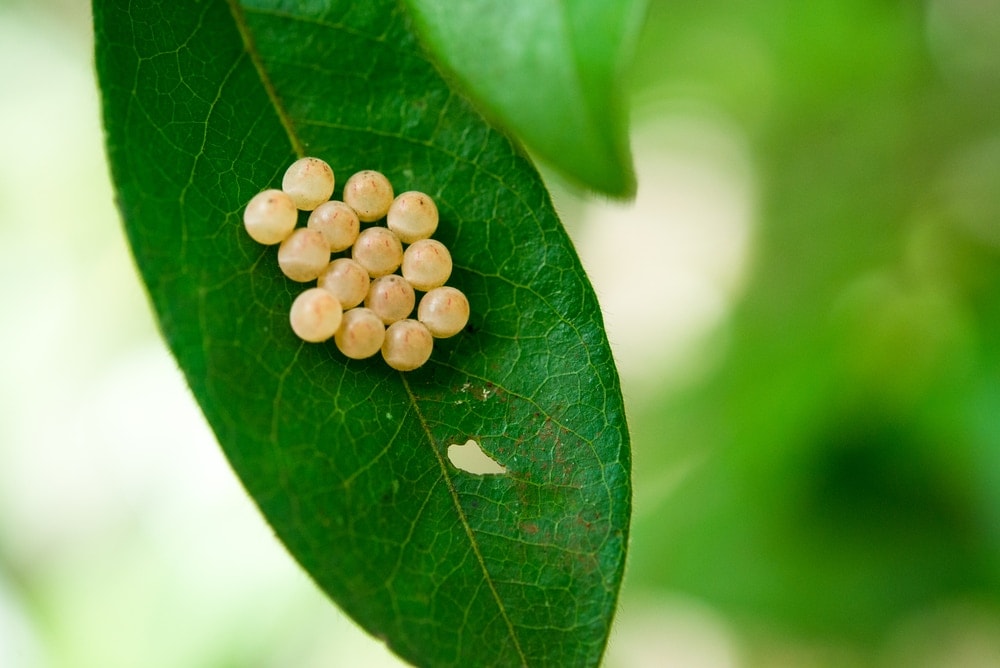
First, the eggs are laid on plants by the adult female butterfly. They choose the plants based on the feeding needs of the insects once they hatch. The plant will become food for the insect at that point.
Butterfly eggs are often tiny. Butterflies will lay them at any point through the spring and summer, depending on the speed of their life cycle and their migratory pattern.
II. Butterfly Life Cycle – Caterpillar (Larva)
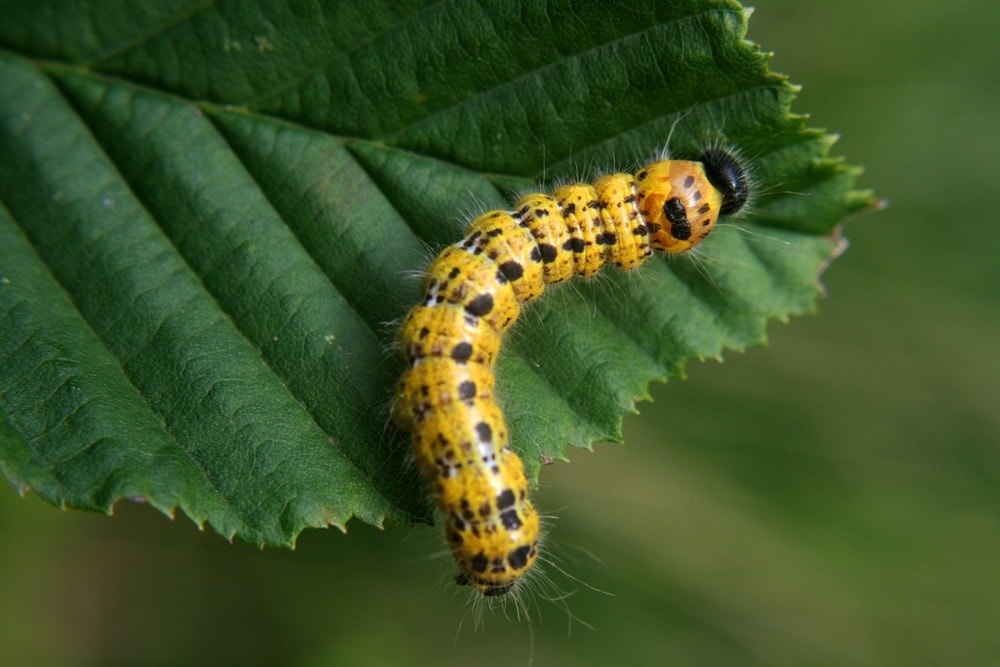
The caterpillar is the friendly name for the general stage of “larva.” It is a caterpillar, whether it is a moth or butterfly species. The primary purpose of a caterpillar is to eat voraciously. They will grow rapidly and shed their skin around four times before reaching the next stage of development.
III. Butterfly Life Cycle – Pupa
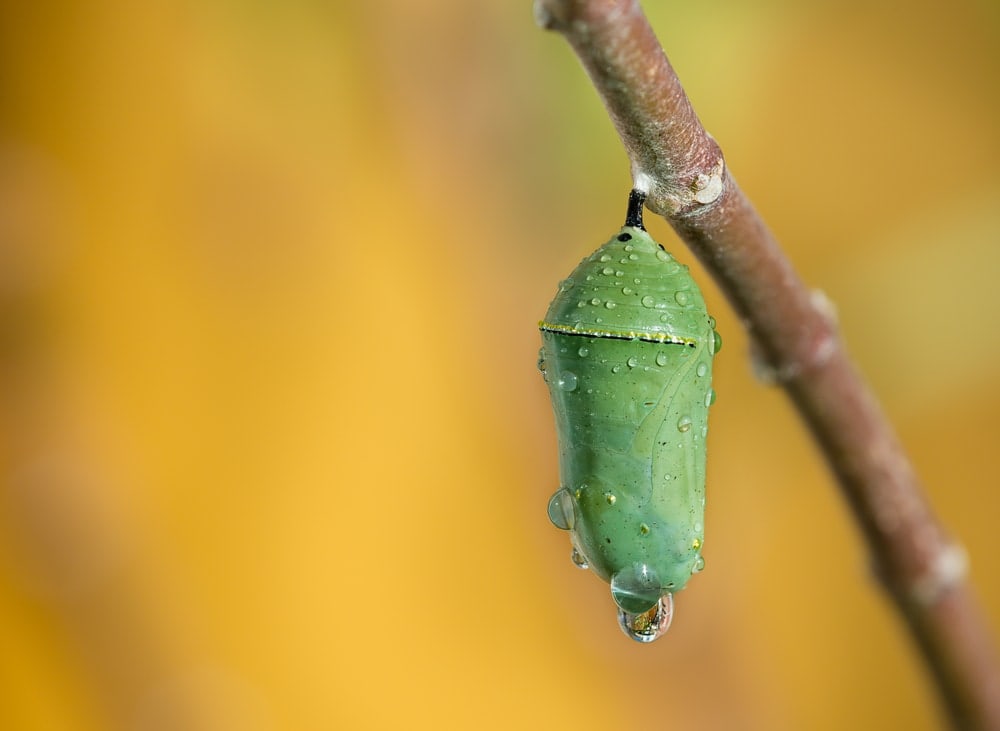
The pupa stage is a transition stage. It is the point at which they transform. Once the caterpillar is fully grown, they stop eating. They form a chrysalis around them, which often starts brightly colored and can finish as a transparent sheath.
Depending on the species, the location, shape and color of the chrysalis can change. The stage can last from a few weeks to a couple of years for certain species.
IV. Butterfly Life Cycle – Adult
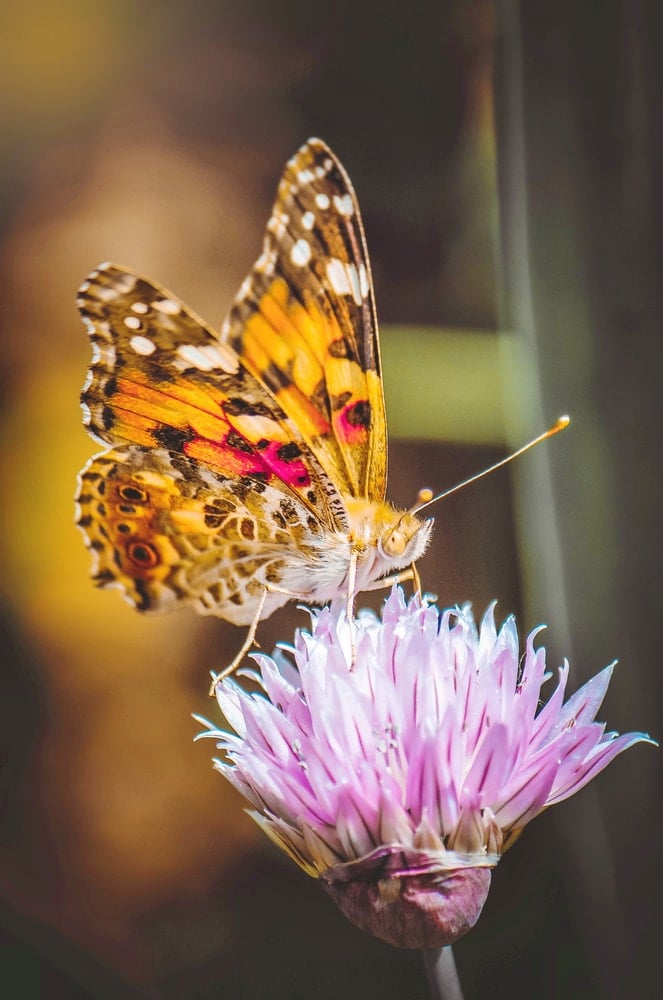
At the end of the pupal stage, the adult emerges as a fully formed butterfly. The adult’s job is to mate and lay eggs. Their migratory pattern will often support this, taking them to the areas in which they need to mate or where they can lay their eggs.
Many adult species will only live for a couple of weeks. However, some species will hibernate throughout the winter to lay their eggs in the spring.
You may also like: Learn the 23 Frog Species Across the Globe and Where You Can Spot Them: With Images, Facts, and More!
The Impact of Climate Change on Butterflies
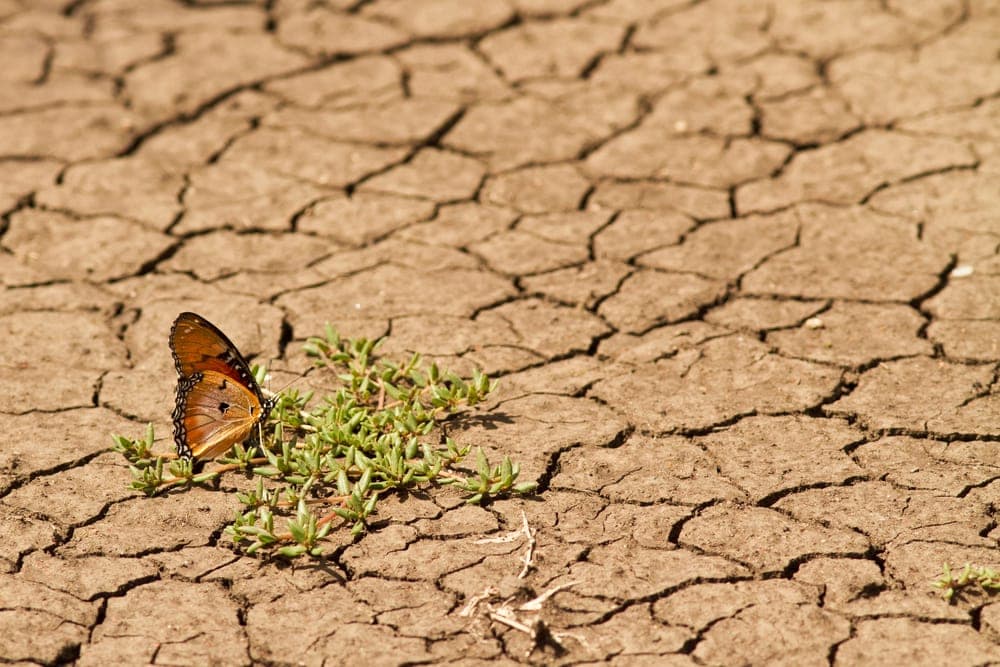
Butterflies often act as bioindicators for the effects of climate change. They are susceptible to their surroundings. They are often very well adapted for specific biomes and climatic conditions.
For example, monarch butterflies have been bioindicators for the effect of climate change. Their migration patterns have changed dramatically compared to their previously typical migration routine.
Migrating butterflies like monarchs need to find forests to overwinter. These need temperatures low enough to slow their metabolism but not so low to kill them. However, there are higher temperatures during autumn and erratic freezing events nowadays. These have threatened the butterflies’ ability to survive throughout their hibernation.
Human degradation of influential landscapes makes it even more difficult. Sensitive species can’t adapt to the changing climate.
Many of the changes for butterflies that are caused by climate change include a movement in their migration pattern. For example, many butterflies have had to move northward from their typical breeding grounds. They might also move upward in elevation to combat higher temperatures.
In the end, climate change will end up affecting species’ in almost every aspect of their lives. That will include:
- Life cycles
- Flight times
- Survival
- Plant and insect interaction
Plant and insect interaction means the misalignment of the pollinating species with their food plants. For example, there have been recorded instances of disruption with a butterfly’s foodplants. That includes checkerspots and their caterpillar’s food plants.
The breakdown of these relationships is bound to have cascading effects in their environments. As a result, there has been a call over the last several years for more significant studies on the Lepidoptera. A better understanding of their needs helps us understand what we can do for them.
You may also like: Learn the 47 Different Types of Pine Trees, From Flammable to Edible: Facts, Images, and More!
Five Interesting Butterfly Facts
1| The origin of the word “butterfly” has to do with witches and magic.
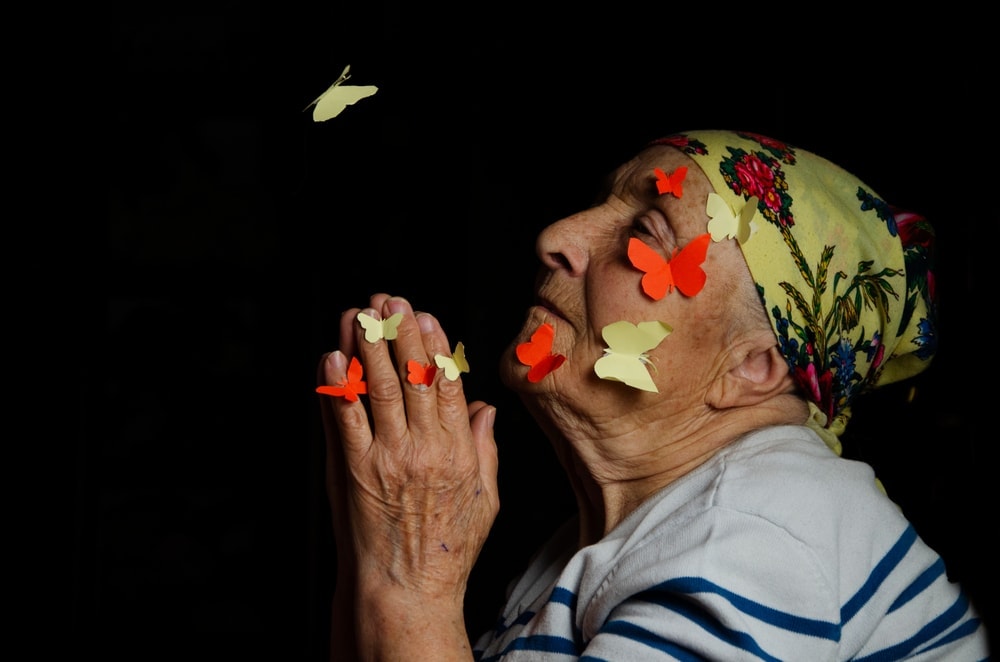
Etymologists believe the word comes from Old English. The old word was ‘butterfleoge.’ There are many theories about where the term comes from, but the most common one has to do with witches of lore.
Ancients believed that witches would resemble butterflies in shape and size. They would use this form to steal milk and butter. Hence, the actual insects ended up getting the name ‘butterfly.’
Another theory is that the name comes from a member of the Pieridae family. Early naturalists in Britain called the Brimstone butterfly (Gonepteryx rhamni) the ‘butter-colored fly.’
2| The Cabbage White is likely the most common butterfly in North America.
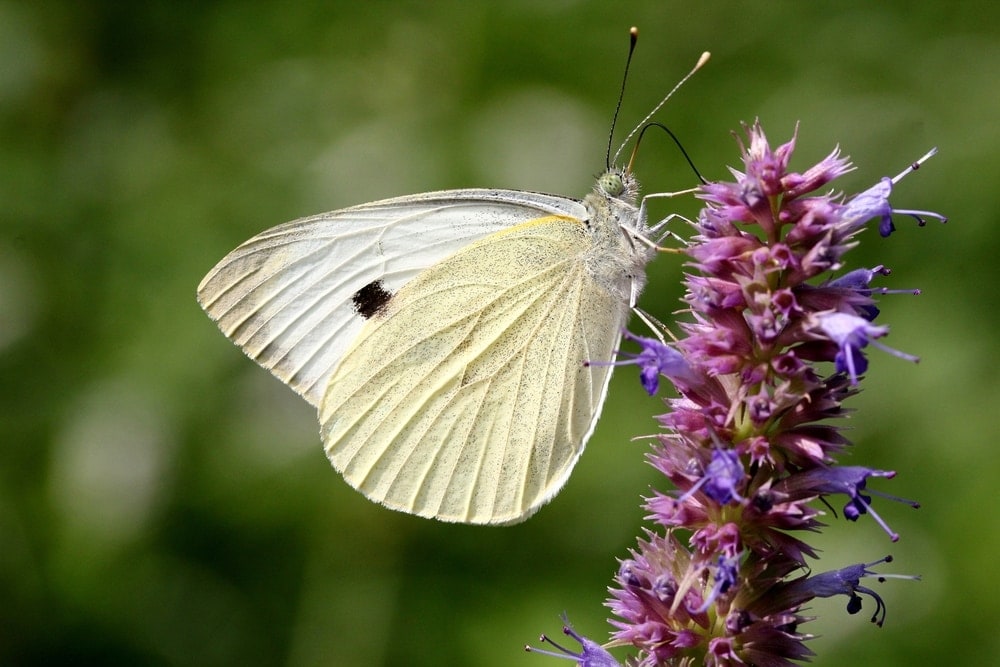
The Cabbage White butterfly is a mid-sized butterfly that usually has a combination of white, cream, yellow and black marbled wings. They can also have greenish marbling on the wings. It is not only one of the more common butterflies globally, but it is also the most common butterfly in the U.S.
3| The Lotis Blue (Lycaeides argyrognomon lotis) is one of the rarest butterflies in the world.
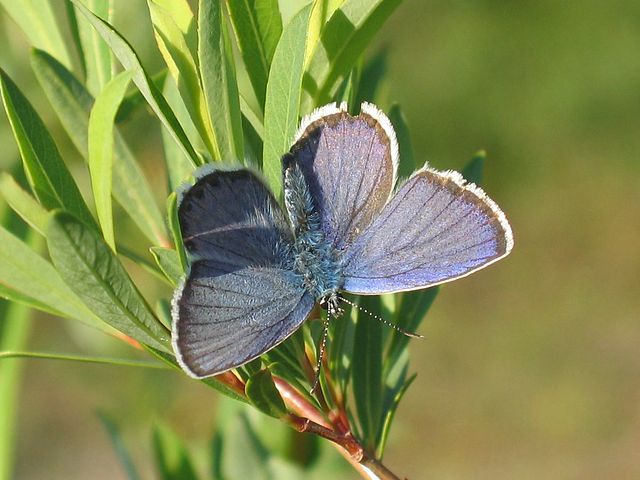
The Lotis Blue Butterfly is a small butterfly with only a wingspan of about an inch (2.5 cm). They are beautiful blue butterflies that live throughout most of northern North America. They are endangered butterflies due to fires burning through much of their native peat regions.
There have been reports that this butterfly is extinct. It has been rediscovered many times even after years of pulling a disappearing act. This time, the butterfly has not been seen in the wild since 1994. Some conservationists believe they may still live in remote areas along California’s northern coast.
4| Queen Alexandra’s Birdwing is the largest butterfly in the world.
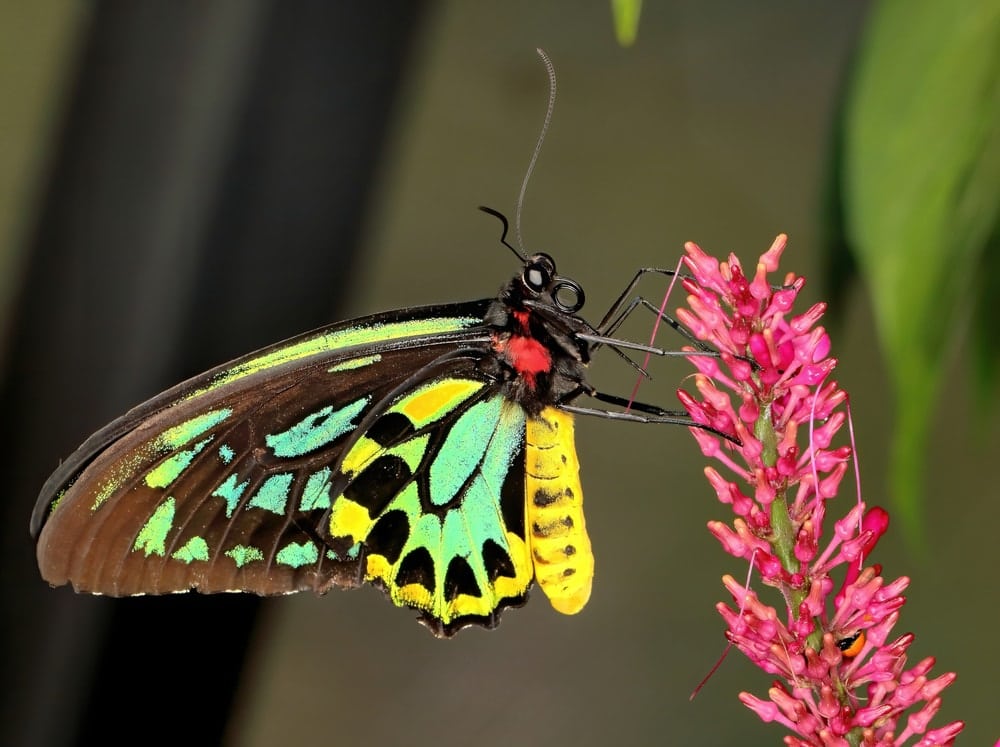
The largest butterfly in the world is Queen Alexandra’s Birdwing. They have a wingspan of more than 11 inches (30 cm). That makes these butterflies about ten times the size of a typical butterfly species.
These butterflies are native to Papua New Guinea. They were only discovered back in 1906 and had since then faced endangerment and even extinction. The booming palm oil industry highly threatens them. The density of the butterfly had slowly decreased to only 10 per square kilometer.
Luckily, there are focused conservation efforts now. They help to save and advance the populations of these valuable species.
5| The Western Pygmy Blue Butterfly is the smallest known butterfly in the world.
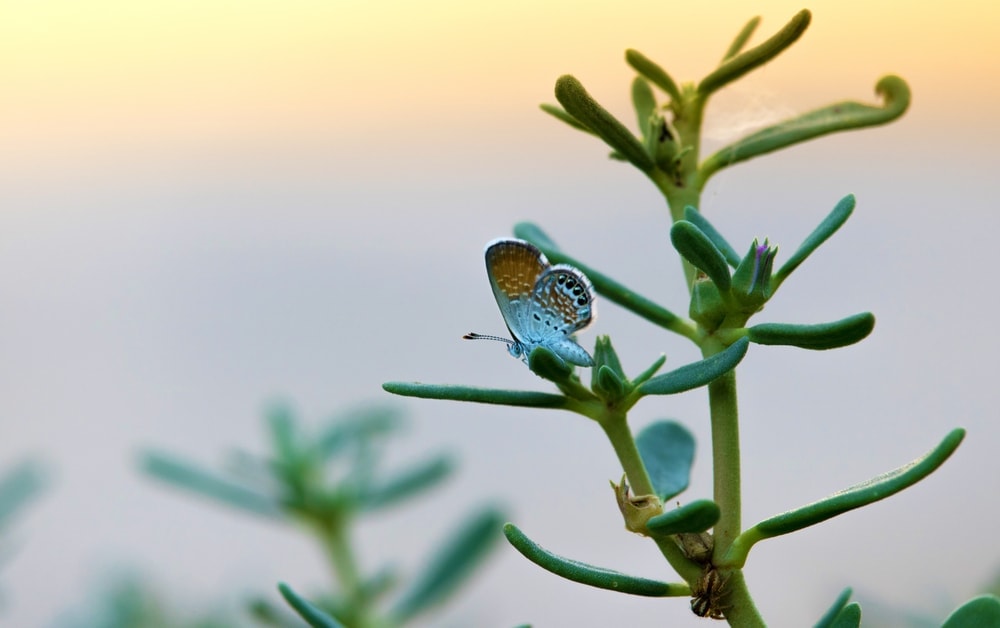
The Western Pygmy Blue Butterfly is the smallest known butterfly in the world. They have a wingspan of 0.5 inches (1.3 cm). They live throughout North and South America. These tiny butterflies have slate blue colors on their bodies and inner portions of their wings. This fades into brown, with black rings and white strips on the outside of the wing.
There are more than 17,500 species of butterflies globally. Surprisingly, only 750 of these are found in the United States. We have highlighted many of the most common species you could find if you are on an identifying mission. We have also summarized some of the intricate parts of the classification system to make it more straightforward.

You May Also Like: Your Guide to the Different Types of Stink Bugs with Images and Fun Facts!
The Classification of All Different Butterfly Types
Butterflies belong to the class Insecta. From there, all butterflies and moths are pulled out into the order Lepidoptera. There are seven families of butterflies. These contain thousands of species distributed across the world.
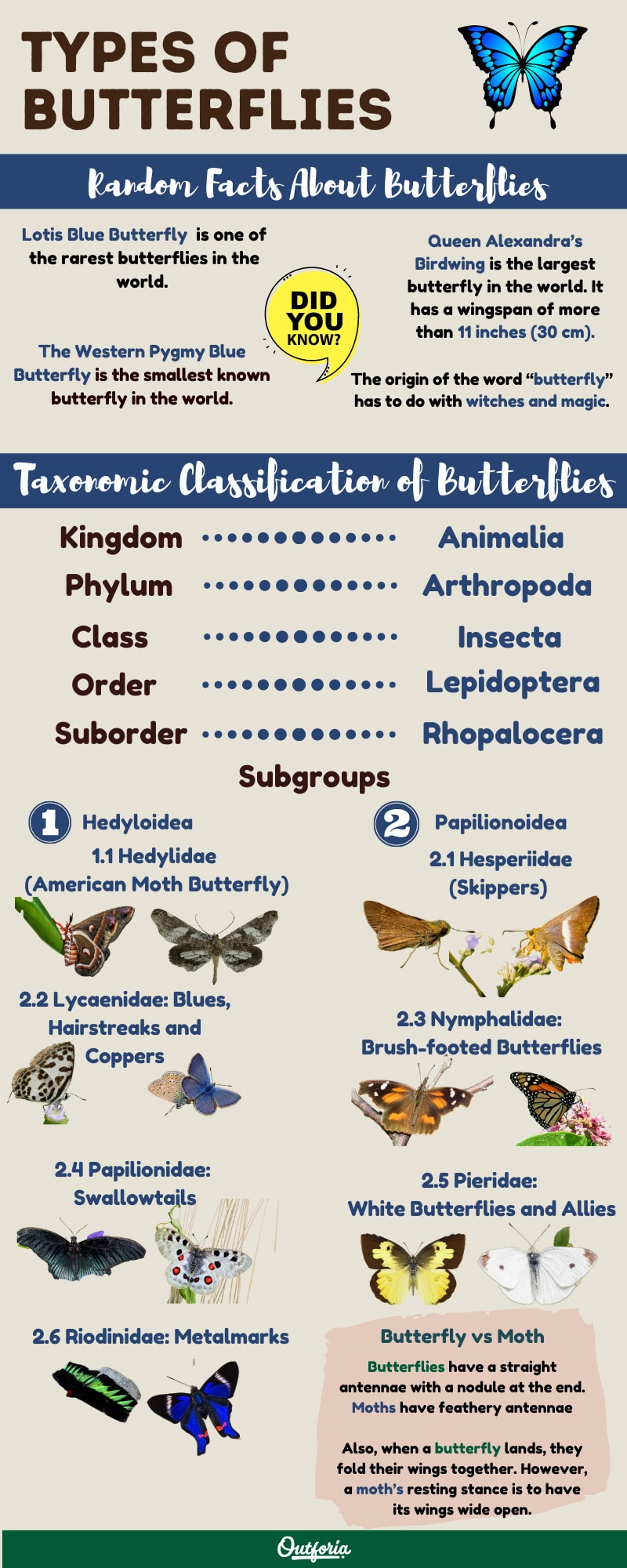
Share this Image On Your Site
<a href="https://outforia.com/types-of-butterflies/"><img style="width:100%;" src="https://outforia.com/wp-content/uploads/2021/11/Types-of-Butterflies-Infographic.jpg"></a><br>Types of Butterflies Infographic by <a href="https://outforia.com">Outforia</a>How are Butterflies Different from Moths?
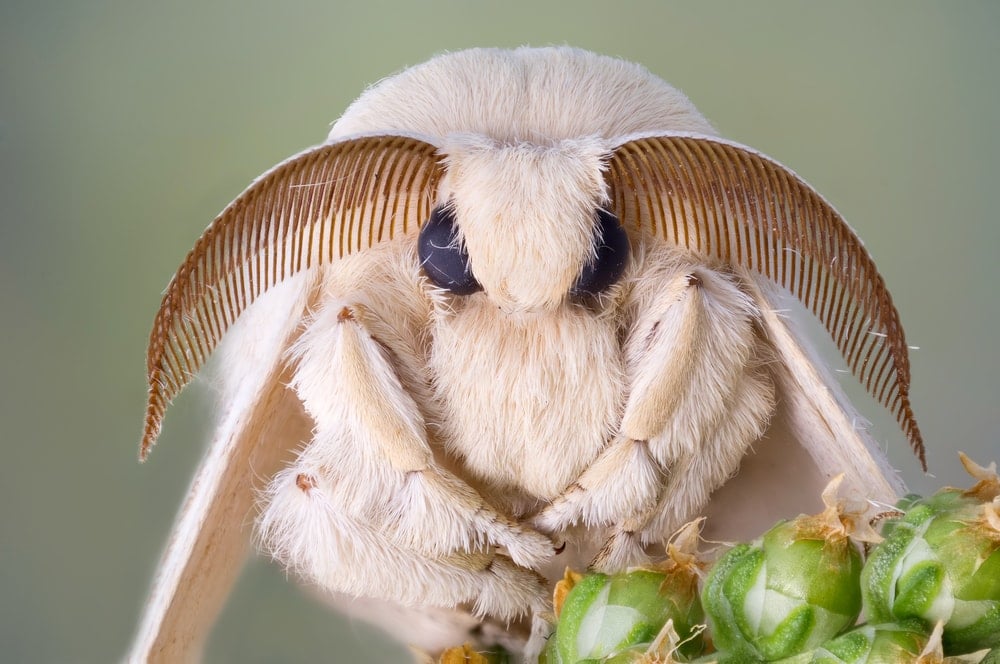
Butterflies and moths are related, but there are some critical differences between the two. These include both physical aspects that you can use to tell them apart and scientific definitions.
Butterflies and moths are both in the order Lepidoptera under the class Insecta. From there, moths and butterflies will be in different families, subfamilies and genera from one another.
In general, it is somewhat easy to tell moths and butterflies apart from each other. Butterflies are often bright-colored. Moths tend to be dull, which provides them with better camouflage.
Physically, butterflies and moths are similar. They both have three primary body parts, including the head, thorax and abdomen. They have six legs and four wings, a set of forewings and a set of hindwings. Both of them have wings that are covered in scales.
One of the ways you can tell a butterfly apart from a moth is its antennae. A butterfly has straight antennae with a nodule at the end. Moths have feathery antennae. Sometimes the feathering is discreet, but it is there.
Finally, when a butterfly lands, they fold their wings together. However, a moth’s resting stance is to have its wings wide open.
You may also like: Get to Know More About the 14 Different Types of Birds of Pennsylvania: Complete with Images, Facts, Descriptions, and More!
The Different Types of Butterflies Breeds
1.0 Family Hedylidae: American Moth-Butterflies
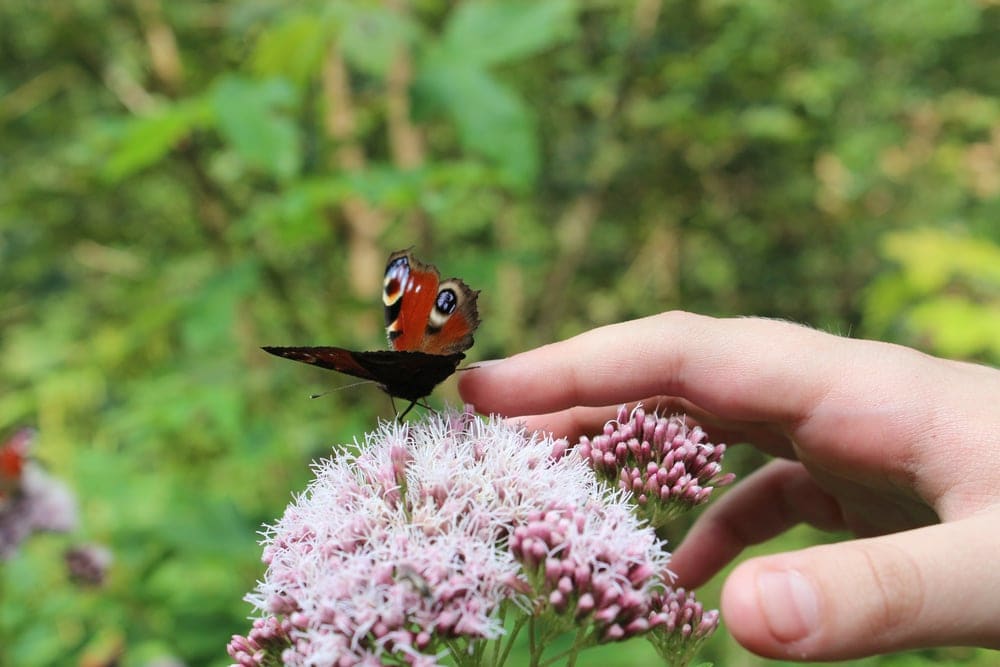
Hedylidae moth-butterflies are an interesting grey area between butterflies and moths.
They were viewed as an extant sister group to the superfamily of butterflies. However, in 1986, naturalists combined the group into a single genus called Macrosoma. This genus is a novel group of butterflies and is the only group of butterflies that doesn’t fall under the superfamily Papilionoidea.
1.1 Macrosoma hyacinthina
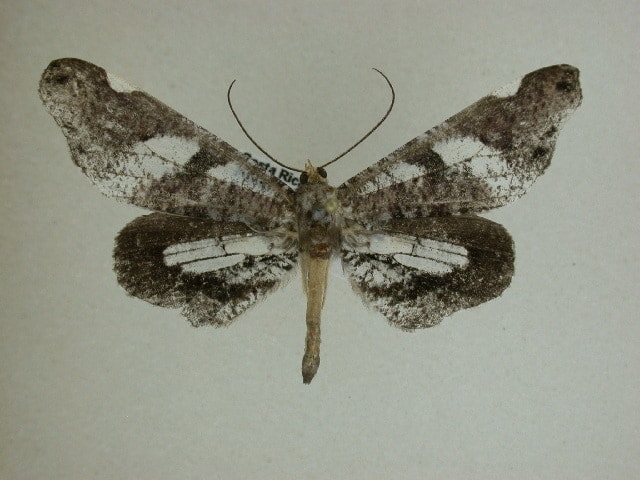
Naturalists described this moth-like butterfly in 1905. Initially, it was a part of the genus Lasiopates. However, it joined the Macrosoma genus along with the others in 1986. Although it has the defining characteristics of a butterfly, its coloration makes it look more like a moth.
Like the rest of the species in the genus, it is a neotropical butterfly. The species lives in Costa Rica, Ecuador and part of Brazil. They do not have a migratory pattern.
2.0 Family Hesperiidae: Skippers
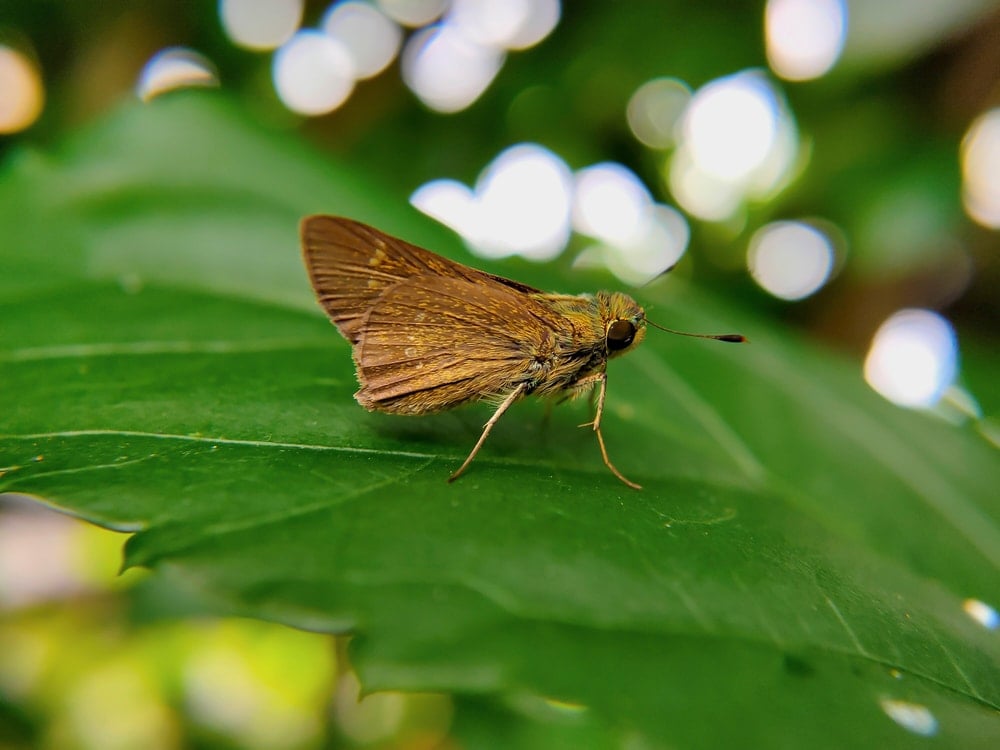
Skippers are another genera in the order Lepidoptera that blur the line between moths and butterflies. Since they are diurnal, they are called butterflies. Many of them have brown tones across their wings and bodies. This coloring can make them difficult for an untrained eye to differentiate from moths.
There are more than 3,500 species of skippers recognized around the world. The majority of them live in the Neotropical regions of Central and South America.
2.1 Coliadinae: Awls, Awlets and Policemen
The Coliadinae subfamily includes all the species of butterflies from the Old World tropics. There are 150 species of skippers under this subfamily. They contain some of the smaller skipper butterflies.
2.1.1 Orange-Tail Awl (Bibasis sena)
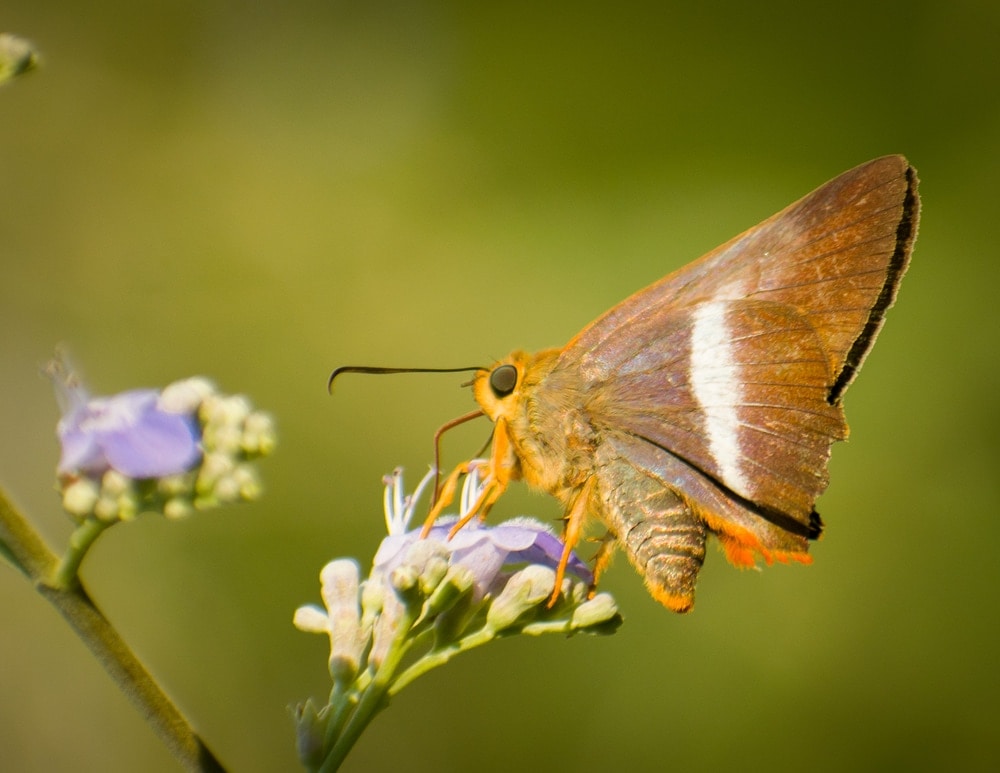
The Orange-Tailed Awlet, or the pale green awlet, belongs to the family of Skippers. They have a wide range throughout Southeast Asia. Their typical locality is in the Bengal region. Throughout most of India, they are pretty rare. However, from southern Myanmar into the Malay peninsula, their population density increases.
These butterflies have tan to dark brown colors on their upper wings. Their underwings are more colorful, with a stripe of bright white and blue. The back of their hindwing is bright red, and they have an orange underbody and legs.
2.2 Euschemoninae: Regent Skipper
This one of the skipper subfamilies only includes one species. The Regent skipper was a previous member of the Pyrginae subfamily. However, they have distinctive colorations, patterns and distribution. That is why natural vsts moved them into their genus in 1897. They have not moved since then, as no other species are like them.
2.2.1 Regent Skipper (Euschemon rafflesia)
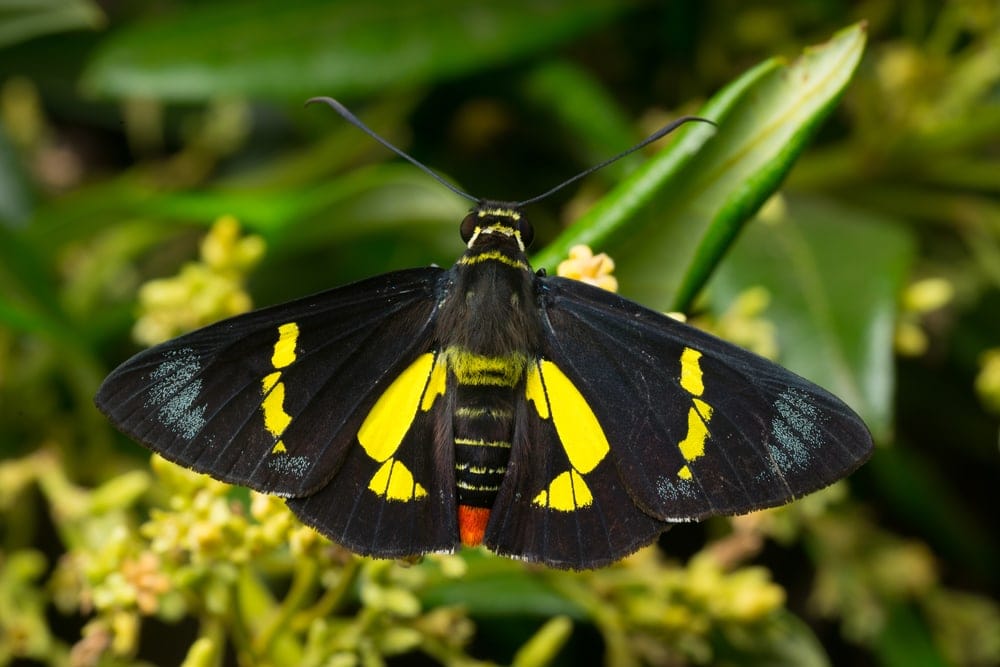
The Regent Skipper is unique. Their wings and bodies are almost all pitch black. Overlaid is a spotted pattern of yellows and light blue. They also have a bright red tip to the last segment of their body. The Regent Skipper only lives in Australia.
2.3 Eudaminae: Dicot Skippers
The Eudaminae subfamily is found in the Neotropics. There are specific genera that extend their zone into more temperate parts of North America. One genus might later move to a different subfamily due to its puzzling location in East Asia.
There are a total of 55 genera in this subfamily. However, we have only picked out the most common and the type-species from them all.
2.3.1 Brown longtail (Urbanus procne)
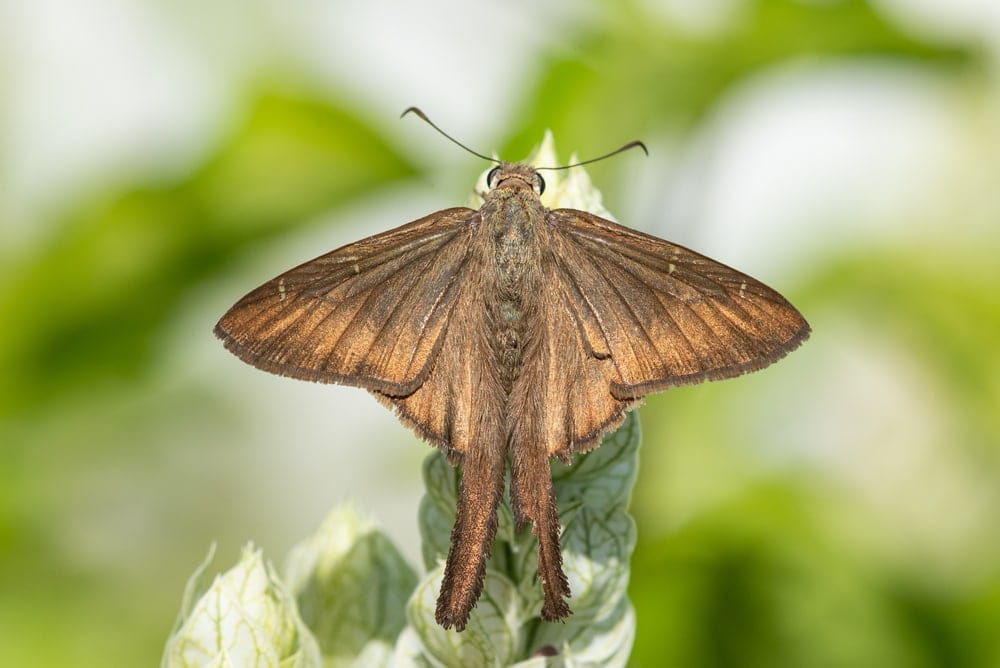
The Brown Longtail lives throughout Argentina, Central America and southern Texas. They are mid-sized butterflies with a wingspan of 1.5 to 1.9 inches (37 to 48 mm).
Much of the study of this butterfly has been on those that live in southern Texas. There are three generations of Brown Longtail per year there. The larvae aren’t damaging since they only feed on non-commercial grasses.
2.4 Pyrginae: Spread Winged and Firetips
These skippers have some of the more decorative patterns. Most of their colors don’t range too far from brown tones. Their common name is Spread-Winged Skippers. Unlike the typical butterfly, their resting position is with their wings spread open.
Hermann Burmeister first established this subfamily in 1878. There were dramatic changes to the subfamily for years. New technology has cleared up the relationships between the genera in this subfamily.
2.4.1 Tropical Checkered Skipper (Pyrgus oileus)
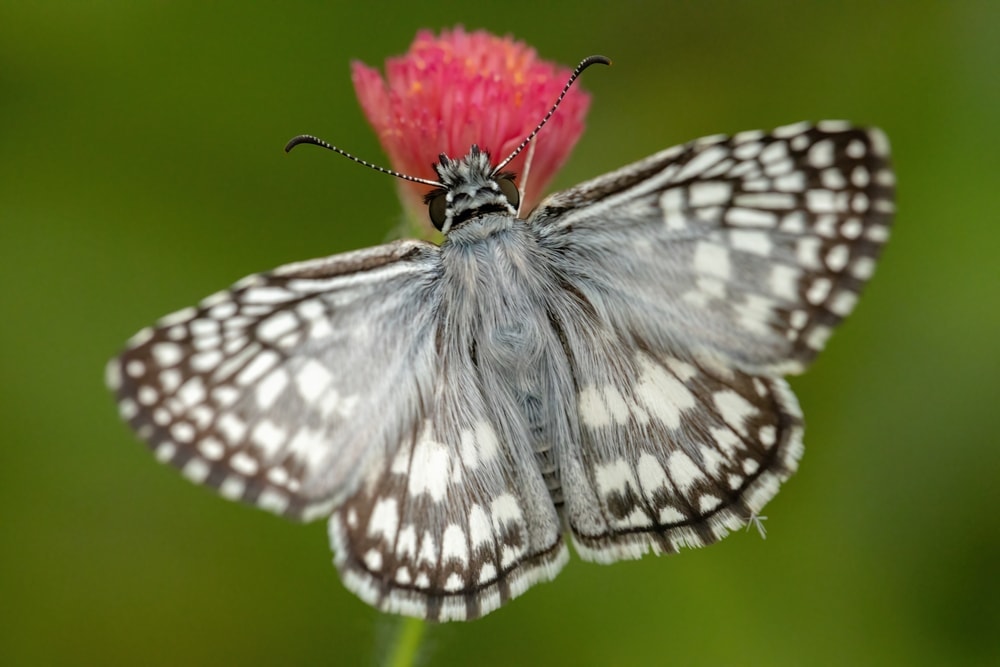
The Tropical Checkered Skipper is a relatively common butterfly from the subfamily. It belongs to the genus Pyrgus, one of many genera separated between seven tribes belonging to the Pyrginae subfamily.
These skippers have a beautiful dusty blue body that fades into their wings. Their brown, orange and white speckled patterns fade in from the blue. They make their home close to their food plants. These include mallows during their larval stage and nectar from the flowers of the plants during their adult stages.
2.5 Heteropterinae: Skipperlings
The subfamily of skipperlings is small in size and the number of species in the subfamily. There are about 150 described species of skipperlings organized into 15 genera. Some of them hold more species than others which are monotypic.
2.5.1 Large Chequered Skipper (Heteropterus morpheus)
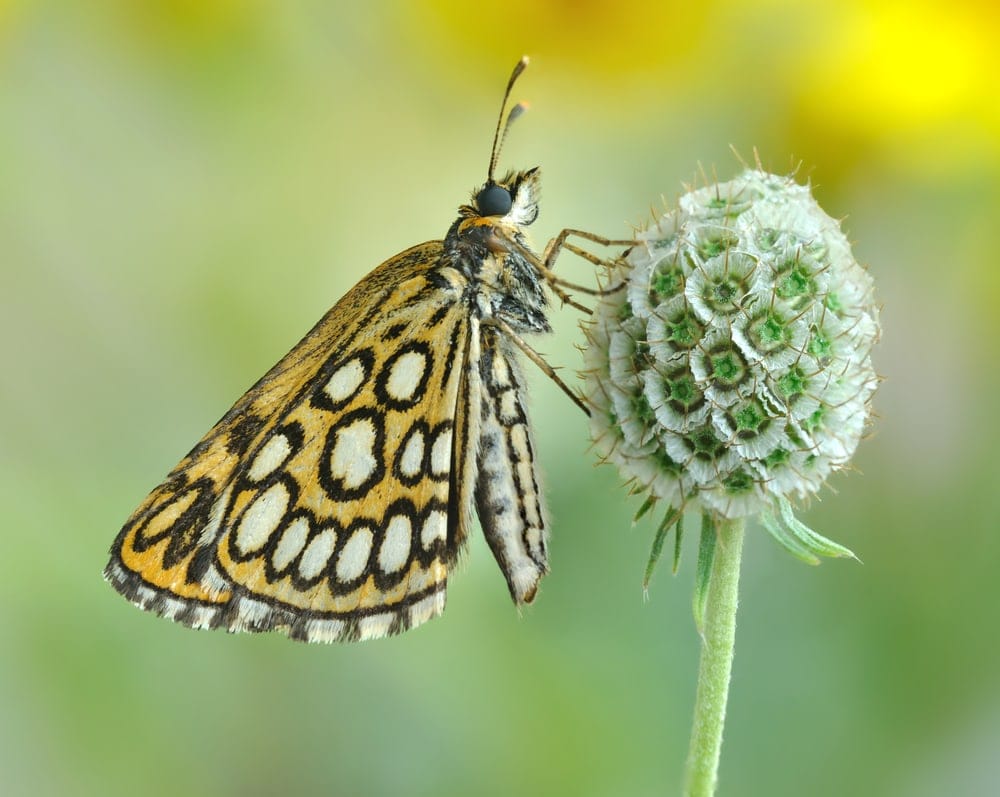
The large chequered skipper is one of the most well-known of the skipperlings. They are the only species in the monotypic genus Heteropterus. Interestingly, most of their populations are isolated from the others. You can find them scattered throughout Europe, Russia, and the Palearctic, into Central Asia and Korea.
These skipperlings have a yellow backdrop with spots of white surrounded by a black ring. The outer edge of their wings oscillates between white and black, along with their bodies. Their upper side is drab but seldom seen.
The flight pattern of this butterfly is one of its most distinctive characteristics. It appears to zig-zag and bounces through the air, almost as though it were intoxicated.
2.6 Hesperiinae: Grass Skippers
Grass skippers are also called banded skippers. Pierre Andre Latreille established the subfamily in 1809. There are more than 2,000 species in this subfamily, making it the largest skipper butterfly subfamily. The species in this subfamily occur worldwide, except for New Zealand. There are 137 of these species that are native to North America.
2.6.1 Swarthy Skipper (Nastra lherminier)
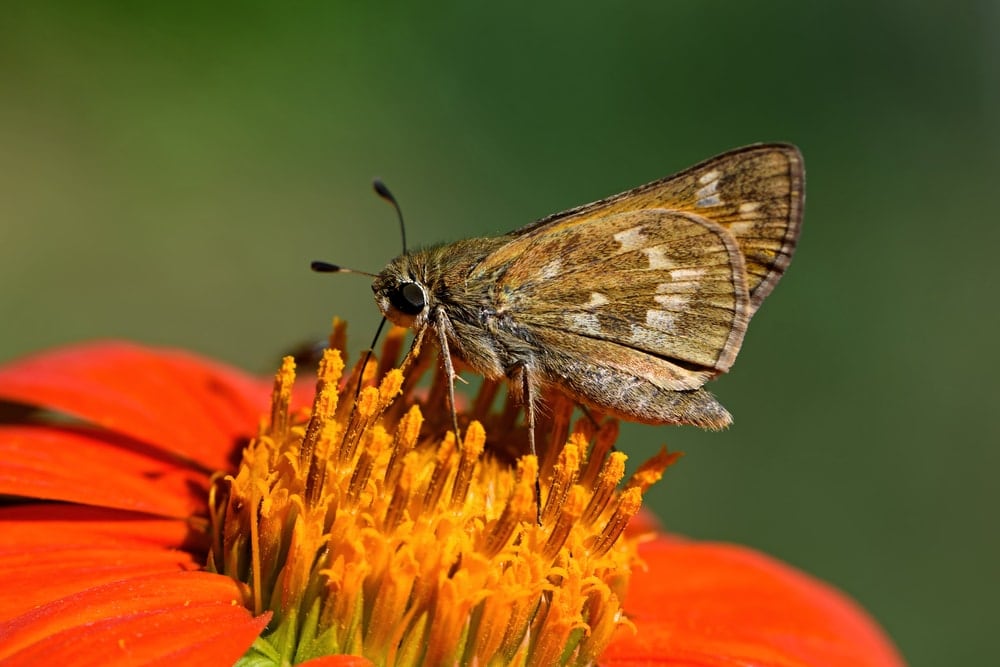
One of the few species of these skippers native to North America is the Swarthy Skipper. Their population is dense throughout the East and Southeast of North America. They have greenish-brown wings and bodies with veins that are light yellow.
These butterflies are called grass skippers because of their propensity to perch on grass stems close to the ground. The caterpillar feeds on Little Bluestem grass, and adults drink nectar from low-growing flowers.
2.7 Megathyminae: Giant Skippers
The next subfamily of the skippers is the Giant Skippers. The species that fall under this title are disputed. Moreover, the subfamily itself is disputable. Many authorities don’t consider this a true subfamily, while others separate it.
As you might guess from the name, these species are larger than most other Skipper species. They have medium- to large-sized butterflies with thick bodies. For the most part, they tend to have brown colorings with yellow markings.
2.7.1 Arizona Giant Skipper (Agathymus aryxna)
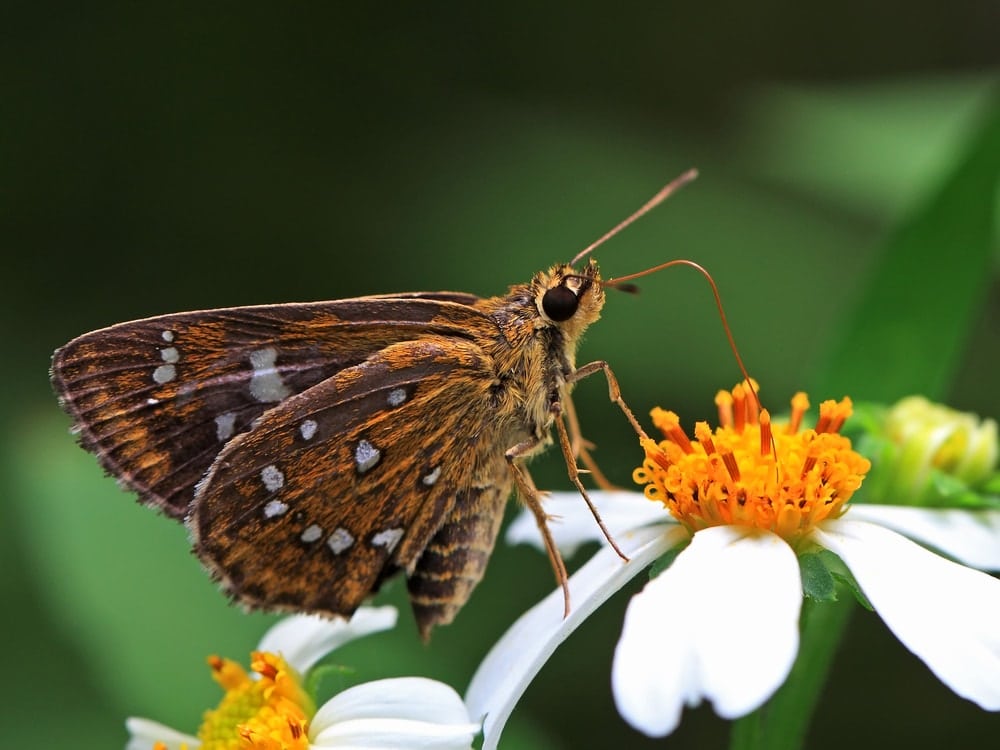
The Arizona Giant Skipper looks like several other species of Giant Skippers but tends to be darker in color. They live in Arizona and throughout northern Mexico and southwest New Mexico. These butterflies prefer Upper Sonoran savannas.
The Arizona Giant Skipper larva prefers the plant host, the Palmer’s Agave. The mature larvae will bore into the underside of the plant’s fleshy leaves. The adults seem to seek nectar rarely. Instead, they fly around canyon mudholes to seek electrolytes.
2.8 Trapezitinae: Australian Skippers
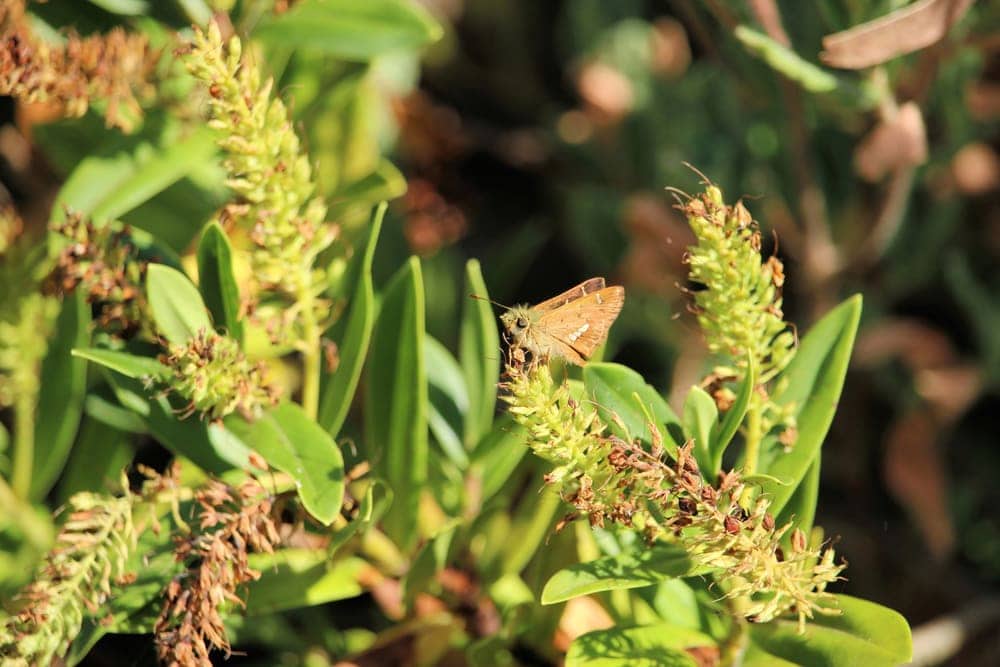
The Trapezitinae subfamily contains about 60 species separated between 16 genera. You can only find these species throughout New Guinea and Australia. There have not been comprehensive studies and research on most of these species. That means there is yet much to learn about their habits. The genera have been defined and organized from 1819 until 1994.
3.0 Family Lycaenidae: Blues, Hairstreaks and Coppers
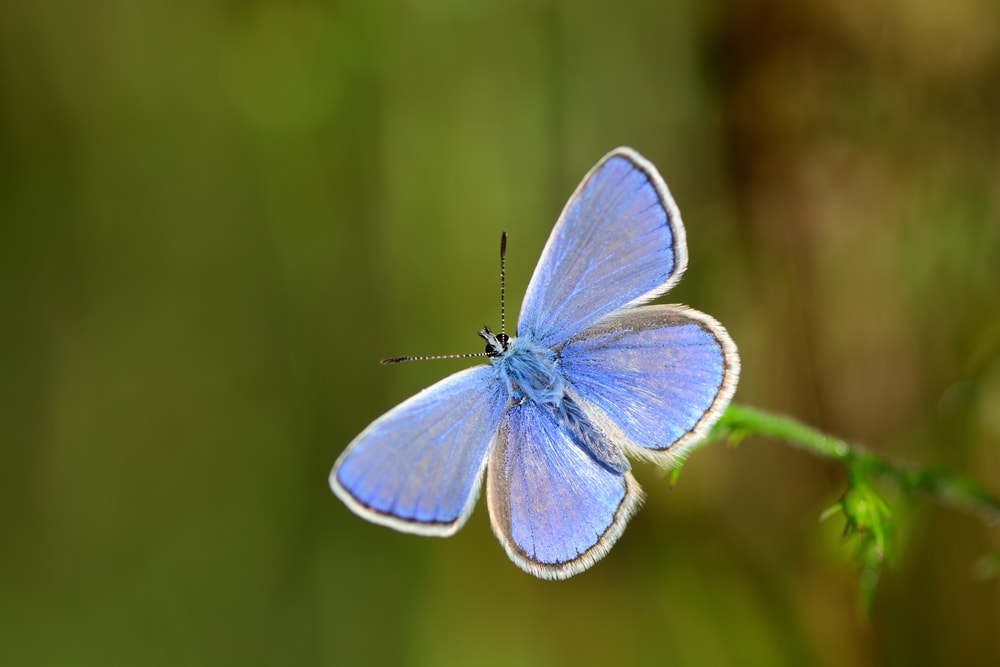
The Lycaenidae family is the second-largest family of the Lepidoptera butterflies. There are more than 6,000 species that fall under this family worldwide. Altogether, the members of these families constitute about 30% of all known butterflies.
Their common name is gossamer-winged butterflies. There are seven total subfamilies within this family. We will pull out some of the most common butterflies under each of these.
3.1 Curetinae: Sunbeams
First, we start with the bright lights of the butterfly seen, the Sunbeams. They make their home throughout Southeast Asia. The curetis genus is currently the only genus in this subfamily. There are about 25 species, some of which are presumed extinct.
3.1.1 Indian Sunbeam (Curetis thetis)
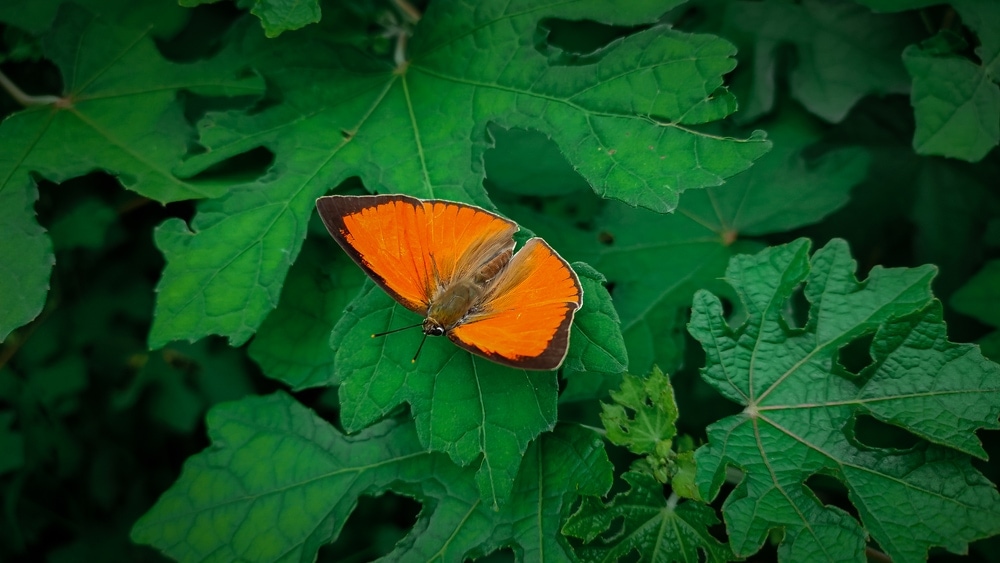
The Indian sunbeam is a butterfly of two faces, so to speak. The upper side of their wings is a bright orange rimmed by black. The underside of their wings is chalky white. The butterfly lives throughout Peninsular India and into the Himalayas. They rely on precipitation, so they cannot live in the desert areas of the region. They can adapt to a variety of food plants.
3.2 Miletinae: Harvesters
Miletinae butterflies are most commonly called harvesters, but they can also go by woolly legs.
One of the aspects of this family that sets them apart from other butterfly subfamilies is the inclusion of predatory larvae. They are phytophagous, meaning they don’t feed on plants. Instead, they eat other insects like ants and aphids.
Some of the members of this family seem to have a complex symbiotic relationship with the ants. However, it is difficult to understand since there is little known about their ecology.
3.2.1 Moth Butterfly (Liphyra brassolis)
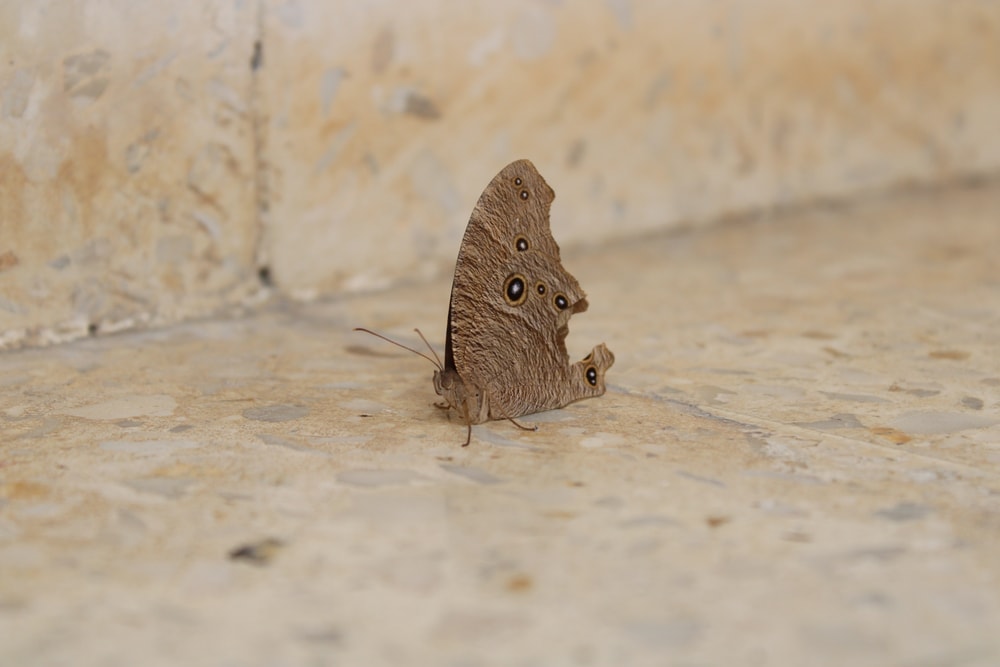
The Moth Butterfly lives throughout South and Southeast Asia. They are one of the exemplar species of the subfamily due to the presence of predatory larvae. This butterfly’s larvae feed on ant larvae. They end up growing into one of the largest species of Lycaenid butterflies.
They are quite a rare species even though they have a wide distribution range. Due to their rarity, specimens of the butterfly are a prized collector’s species.
3.3 Poritiinae
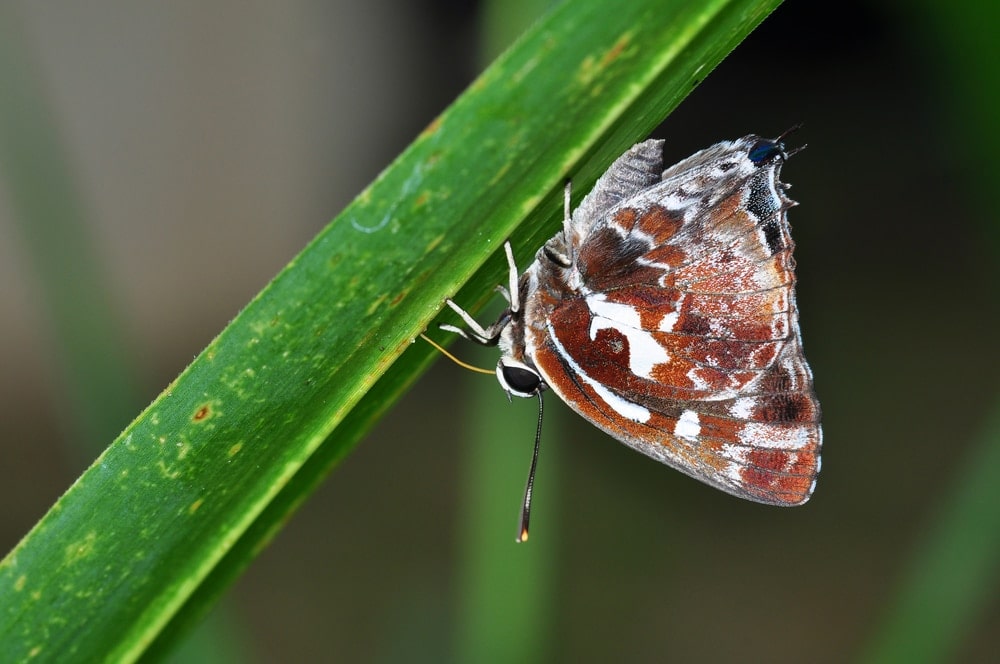
The Poritiinae subfamily is another somewhat unusual group. They have a propensity to feed on algae and lichen instead of typical plants. First, this subfamily is separated into two tribes, the Poritiini and Liptenini. Then, they are divided by subtribe before the genera are broken out.
Most of these species live within Asia. They span the Philippines, Malaysia, Indonesia, India and a little farther North.
3.4 Aphnaeinae
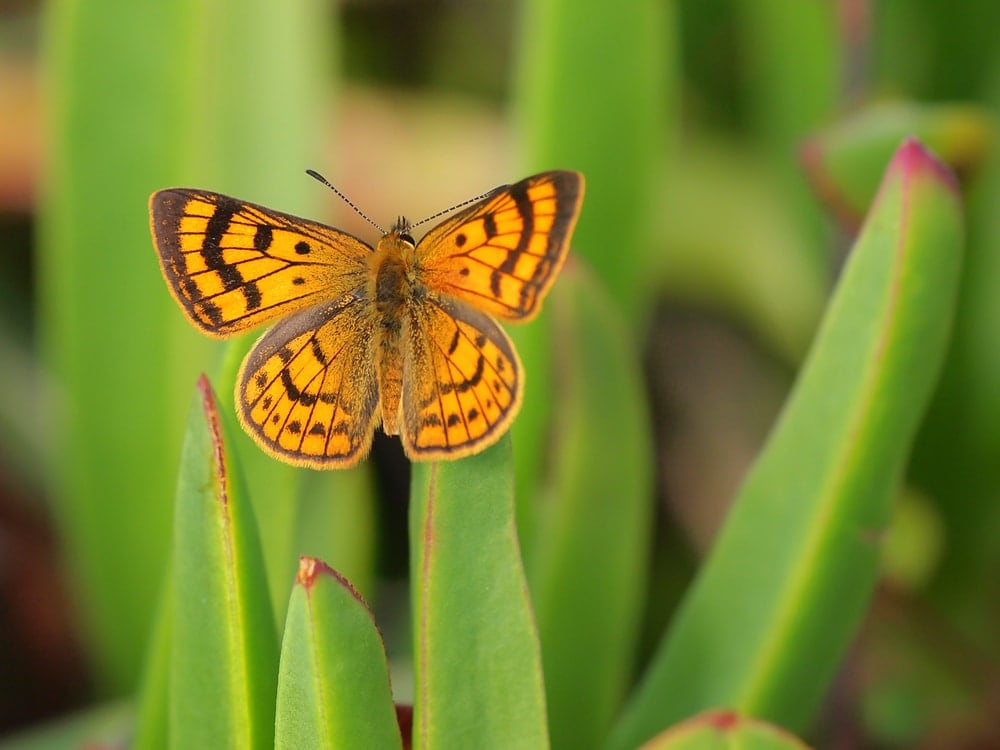
There are only 17 recognized genera and were only recently reclassified as a subfamily instead of a tribe within the next subfamily. They contain some of the Copper butterflies in this family. Most of the butterflies live in Africa and Southeast Asia.
3.5 Theclinae: Hairstreaks and Elfins
Theclinae butterflies include hairstreaks and elfins. They include tropical species for the most part. These will often have a blue coloration on their upper wing to reflect light to make them even more beautiful. The true purpose of this is to make them more difficult for predators to catch.
Few Theclinae species are migratory. They make their home throughout the world, including some species that live in North America.
3.5.1 Great Purple Hairstreak (Atlides halesus)
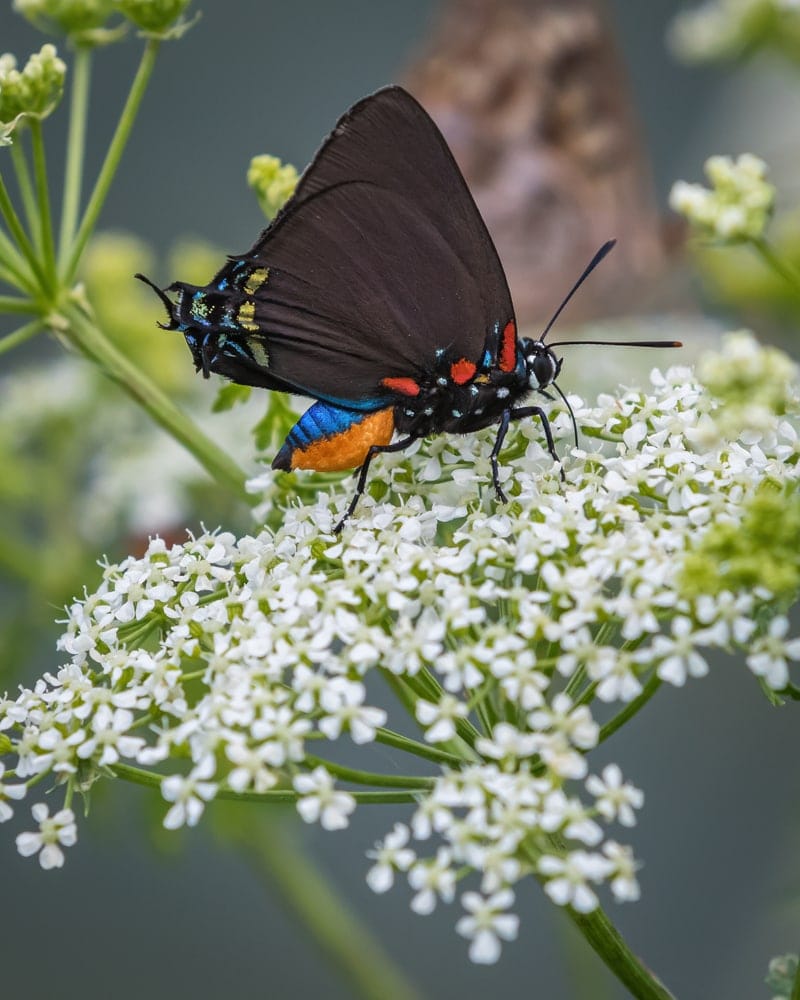
The Great Purple Hairstreak is one of the North American species in this subfamily. They are one of the most beautiful butterflies in the south. Although they are called the Great Purple Hairstreak, they don’t have any true purple on them. Instead, they have black wings with blue, green and orange spots.
3.6 Lycaeninae: Coppers
The Lycaeninae subfamily includes many of the Copper butterflies in this family. However, there are many relationships between the species that aren’t understood yet. Currently, the Lycaeninae subfamily includes two tribes: the Heliophorini and the Lycaenini. The first includes butterflies called Sapphires. The Lycaenini tribe includes the typical coppers.
3.6.1 Scarce Copper (Lycaena virgaureae)
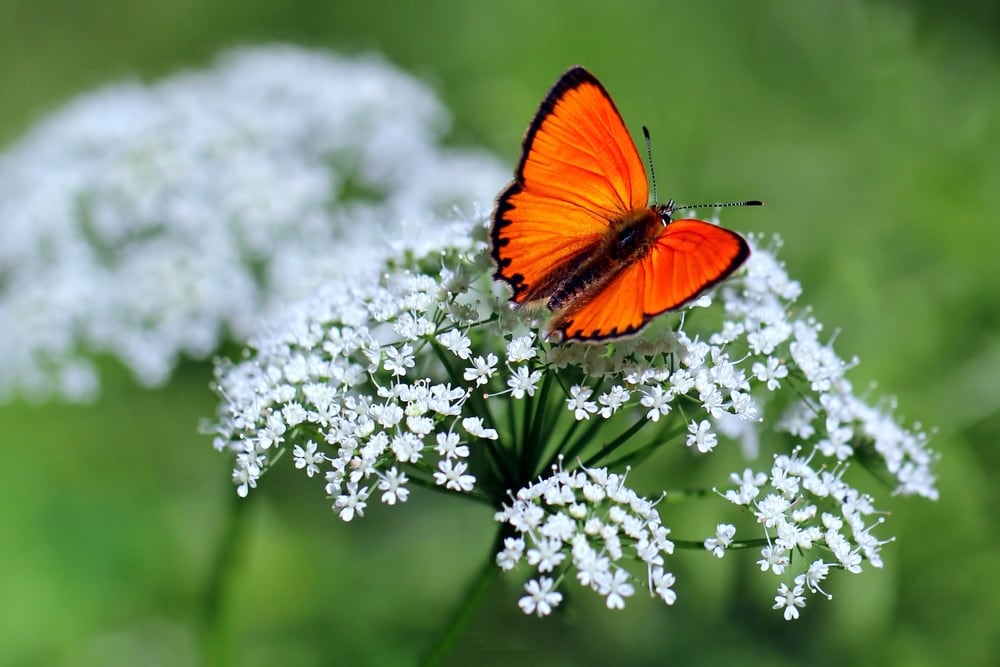
The Scarce Copper is not that rare, unlike what the name would imply. They live throughout Central Europe and reach the Arctic Circle to the North and the Mediterranean to the South. They can even be found as far east as Mongolia.
These butterflies have beautiful under and upper wings. Their upper wings are bright orange with a band of black around the outside. The underside of the wings is a lighter orange with black freckles spanning across them.
3.7 Polyommatinae: Blues
The Blue subfamily is quite diverse. There are plenty of taxa that have unclear relationships even to this day. However, they are getting sorted out and becoming more apparent. There are four primary tribes in this subfamily, including:
- Candalidini
- Lycaenesthini
- Niphandini
- Polyommatinae
3.7.1 Common Blue Butterfly (Polyommatus icarus)
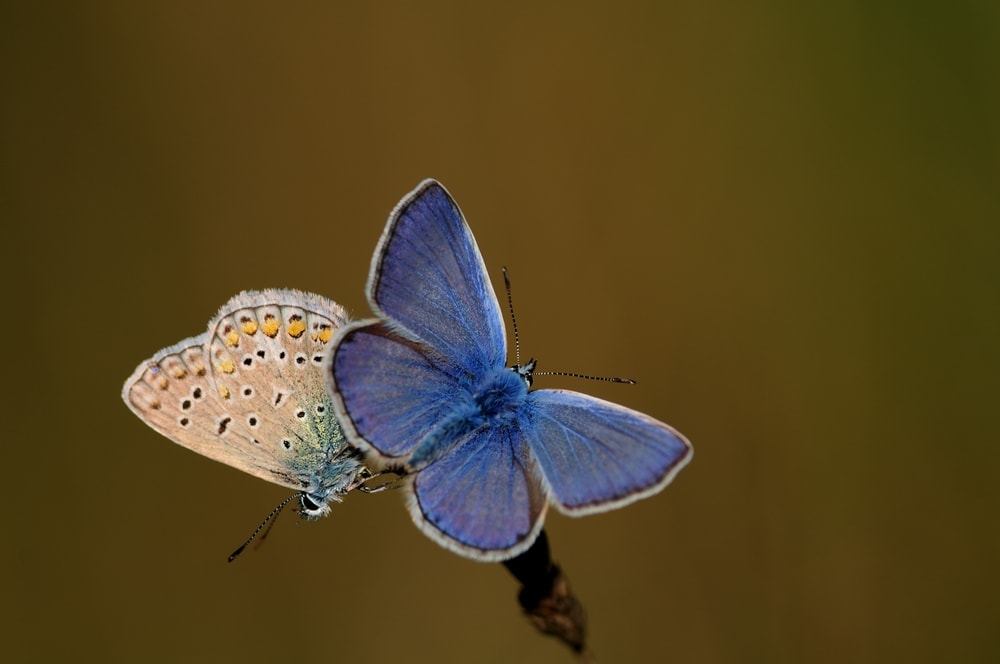
The Common Blue Butterfly belongs to the Polyommatinae tribe. They are one of the most common blue butterflies found globally. The butterfly is found throughout most of the Palearctic.
The male has a brighter blue upper wing with black and white bands around the outside. The female has a light blue dusting of blue close to their bodies. That fades into brown with orange spots around the outside. The underside of both genders’ wings is similar. They are light tan with black and white spots and splashes of orange.
4.0 Family Nymphalidae: Brush-footed Butterflies
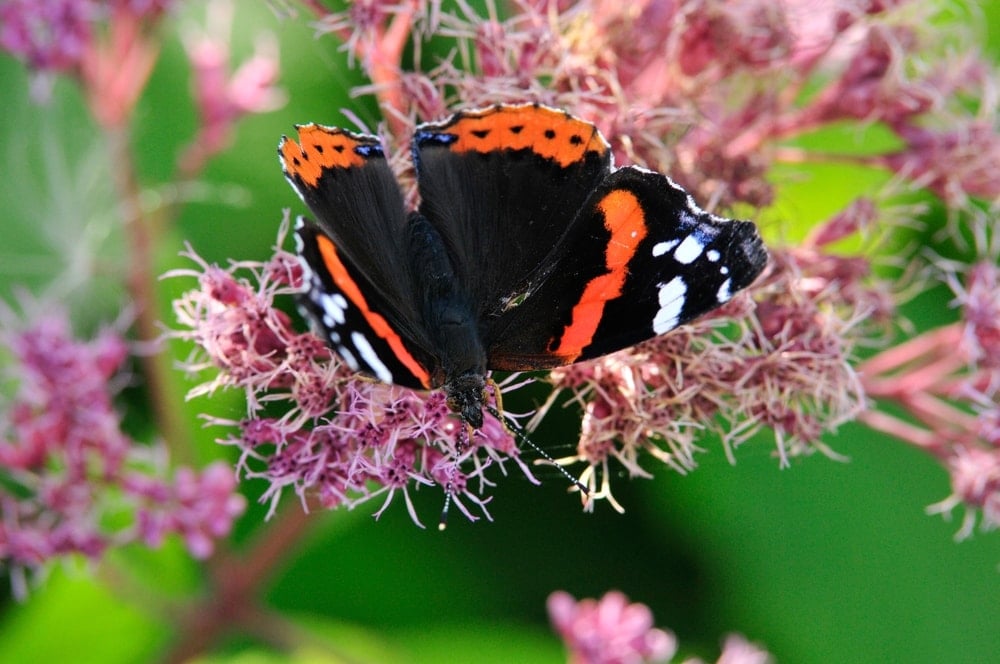
The Nymphalidae family is one of the largest families. They are also the kind of butterflies most people think of since they are often the biggest, brightest and most beautiful butterflies.
The phylogeny of this family is quite complex. There is a minor argument concerning the five main clades of these butterflies, which include:
- Libytheine
- Danaine
- Satyrine
- Heliconiinae
- Nymphaline
4.1 Libytheine Clade: Snout Butterflies
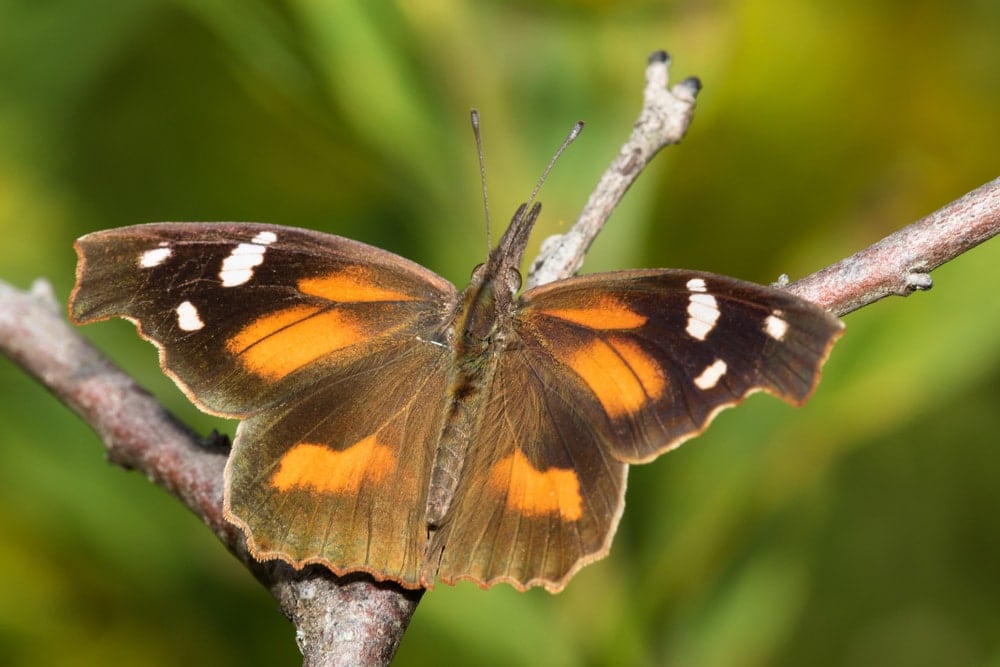
These butterflies are called snout butterflies for a good reason. They have long labial palps that appear like a snout on the butterfly’s head. Most species within this clade are medium-sized and have drab brown colors. When closed, the color and unique shape of their wings keep them camouflaged since they resemble dead leaves.
4.2. Danaine Clade: Milkweed Butterflies
The Danaine Clade includes some of the most commonly recognized butterflies in North America. These butterflies are called milkweed butterflies since they lay their eggs on milkweed plants. There are about 300 species within this clade that live throughout the world. Four of these species live in North America.
4.2.1 Monarch Butterfly (Danaus plexippus)
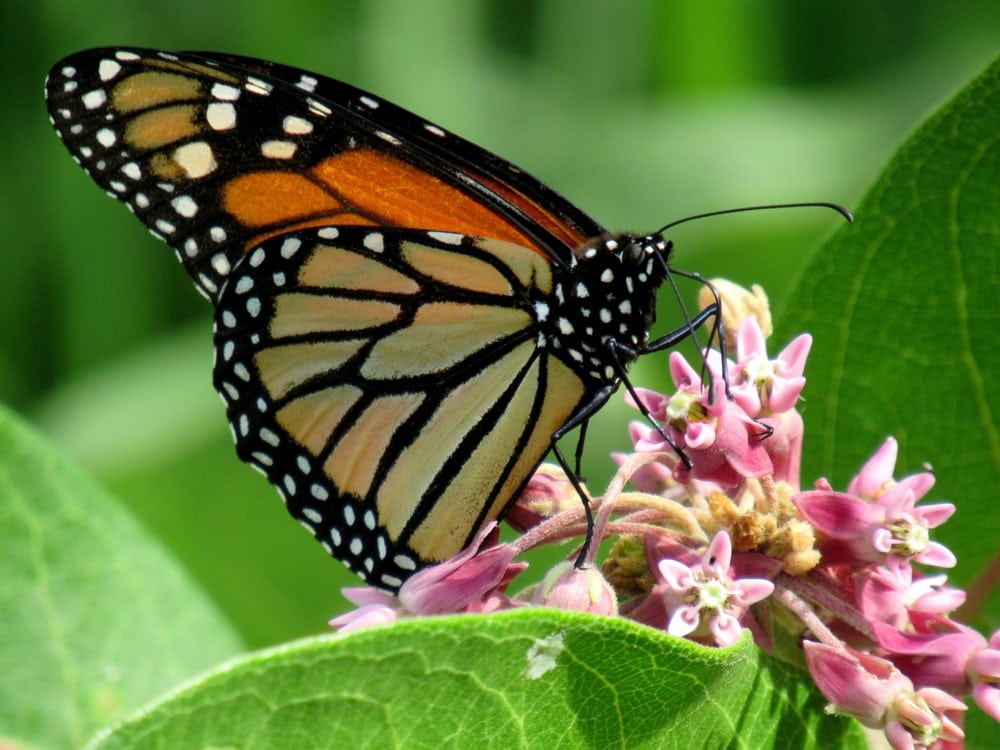
Monarch butterflies are also called Milkweed, Wanderer and the Common Tiger. These butterflies are perhaps the most familiar in North America. Their migratory pattern is well-known, moving them from Canada into Central Mexico during the year.
The monarch butterfly has orange wings with black veining and bands around its outer wings. They are susceptible to their climate. Thus climate change has affected their migration and life cycle processes.
4.3 Satyrine Clade: Canopy, Brown, Owl and Satyr Butterflies
The Sayrine Clade includes species of tropical, alpine and temperate butterflies. The owl butterflies in the Brassolini tribe are unique. Instead of being diurnal, they are crepuscular. Other tribes have spines, and still, others are mimics to help protect them from predators.
4.3.1 Northern Pearly-Eye (Enodia anthedon)
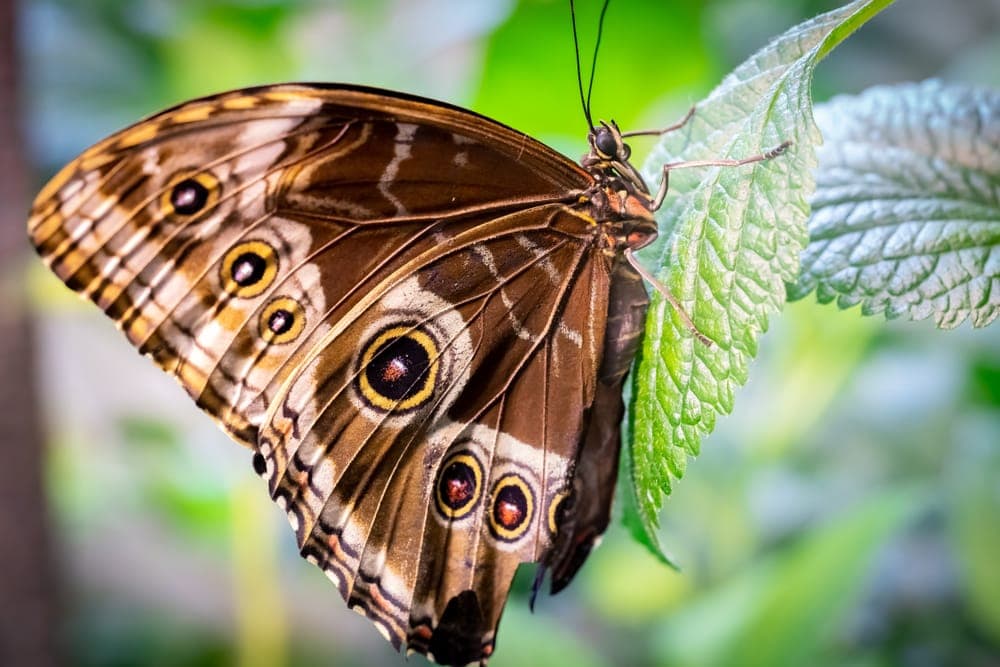
The Northern Pearly-Eye utilizes a protection method across its wings to confuse predators. Their wings on both the upper and underside are covered in black and tan spots that resemble eyes. That way, a predator won’t attack the more fragile parts of their body.
These butterflies live throughout Canada and into Nebraska, down to Alabama and as far south as Mississippi. They feed on grass and overwinters in the larval stage before pupating in the spring.
4.4 Heliconiinae Clade: Colorful Tropical Butterflies
A heliconiinae clade is a group of colorful tropical butterflies. There have been a variety of disputes surrounding the tribes and genera that should be included in this tribe. Some of these are still being changed and waiting for confirmation.
The species in this clade are primarily colorful tropical butterflies. They use a noted form of mimicry called Mullerian mimicry. This mimicry means they often appear similar to other species that predators know are bitter or even poisonous.
4.4.1 Great Spangled Fritillary (Speyeria cybele)
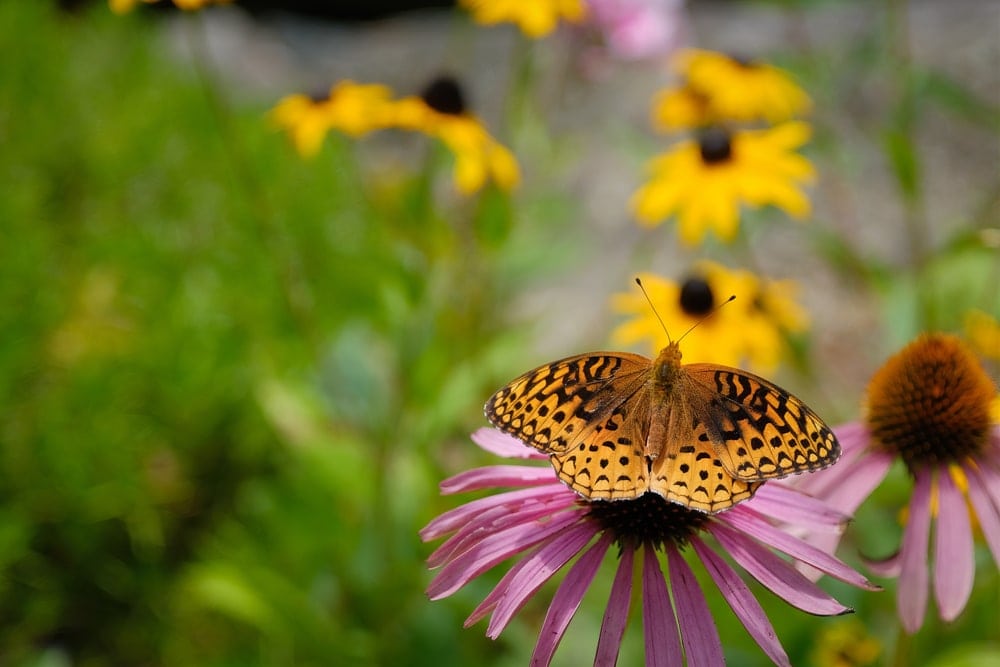
The Great Spangled Fritillary is one of the few non-tropical butterflies in this clade. Instead, they are North American butterflies. Their wings are a variety of brown and gold with spangles of black and white dots throughout.
There are plenty of subspecies that belong to this species, meaning it can have a variety of looks. Some of them are more bright orange with only black spots instead of brown. Native violets often serve as the larval host plant for this butterfly. The adult feeds on the nectar of the flowers.
4.5 Nymphaline Clade: Emperor and Brush-Footed Butterflies
The nymphaline clade is a sister group to the heliconiine clade. These species live all over the world, and many of them are migratory.
4.5.1 Milbert’s Tortoiseshell (Aglais milberti)
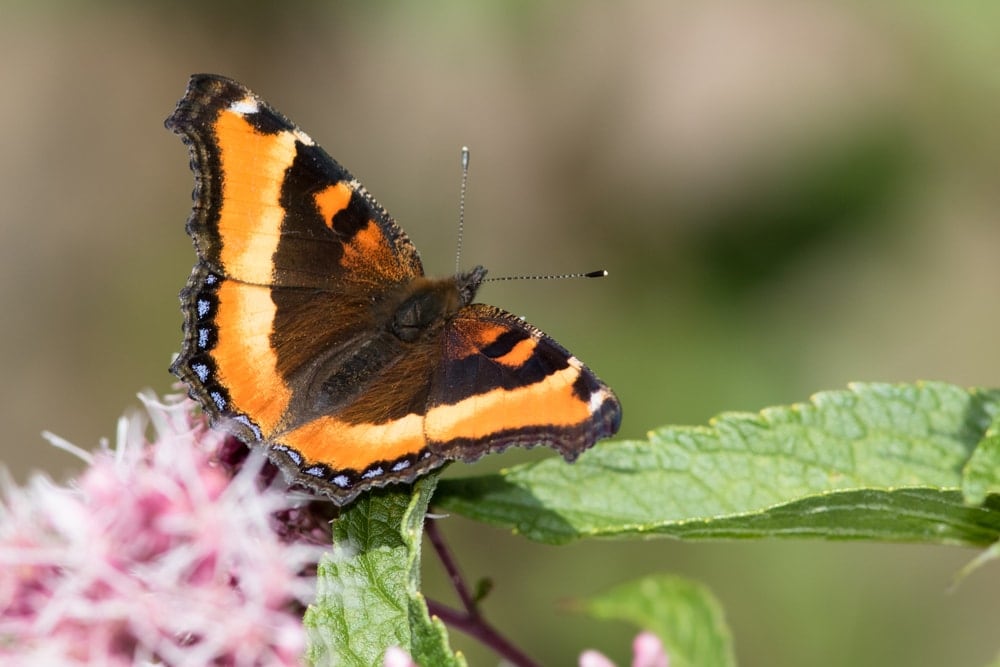
The Milbert’s tortoiseshell is also called the Fire-Rim Tortoiseshell. They are the only species in their genus that occurs in North America. They lie throughout all the United States, preferring wet areas along roadsides and in fields.
It is easy to spot these butterflies since they enjoy flitting around woodland roads. When it lands, it will often temporarily open its wings to show off its coloration. The butterfly has a beautiful blend of cream, blue, orange, tan and brown.
5.0 Family Papilionidae: Swallowtails
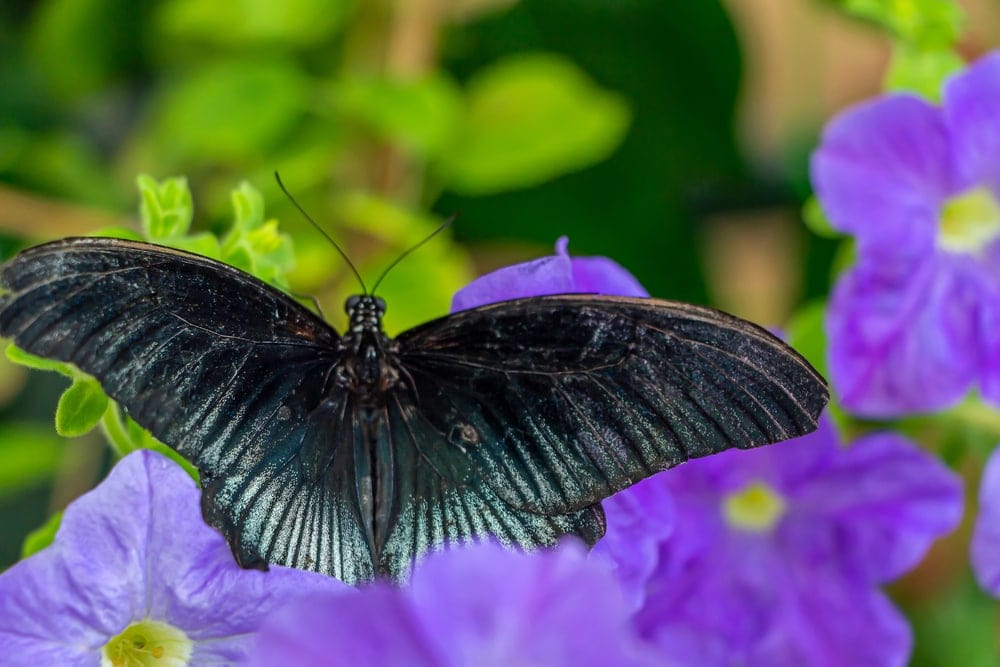
Swallowtail butterflies are some of the most sought-after species in the world. They have unique wing shapes and vibrant color patterns. The family includes more than 550 species, most of which are tropical. However, members of this family live in every continent except Antarctica.
There are two primary superfamilies of swallowtails under which all the genera fall. That includes the Parnassia and the Papilionidae Swallowtails. The latter includes some of the more common species of swallowtails.
5.1 Parnassia Swallowtails
These beautiful butterflies live mostly in mountain habitats. They are sometimes found in other habitats specific to their genera. For example, the Hypermnestra genus prefers arid deserts. The Luehdorfia genus prefers humid forests.
5.1.1 Mountain Apollo (Parnassius apollo)
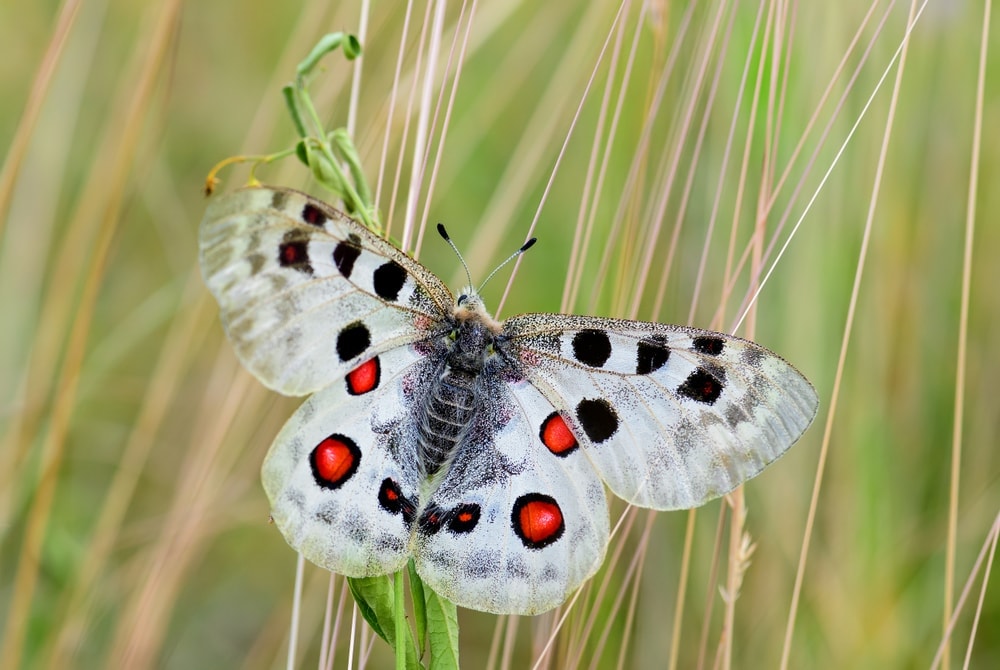
The Mountain Apollo butterfly is named after the deity Apollo. There is little known concerning why it is named after the deity. The mountain species prefers environments on hills and flowery alpine meadows. Many subspecies in this species group have subsets of climatic preferences.
These butterflies are primarily white with partially translucent wings. They have spots of white and red surrounded by a ring of black. Their front wings have spots of black. They have a wingspan that ranges between 2.4 – 3.4 inches (6.2 – 8.6 cm).
5.2 Papilionidae Swallowtails
The Papilioninae subfamily is a widespread species. They are found around the world, but most of them are distributed throughout the tropics. Within this subfamily, there are about 480 total species, 27 of which live in North America. There are three tribes in this subfamily, including:
- Leptocircini
- Papilionini
- Troidini
5.2.1 Tiger Swallowtail (Papilio glaucus)
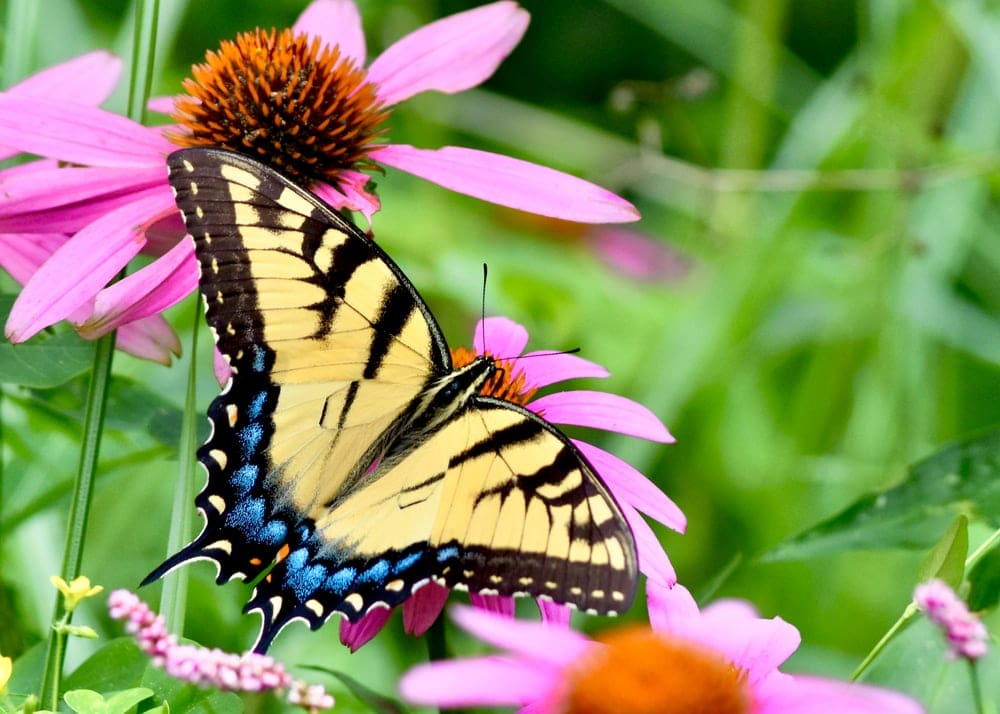
The Tiger Swallowtail is a butterfly species native to eastern North America. They are beautiful butterflies and one of the more familiar species in the area. They make their home in a variety of eastern habitats. It will travel as far north as Winnipeg in Manitoba, Canada. From spring to fall, the females will produce three broods.
The male butterfly, although still beautiful, doesn’t have quite the area of color that the female has. They are both primarily yellow with beautiful patterns of black across their wings. The female also has bright blue and red spots of many hues along the back of their hindwings.
6.0 Family Pieridae: White Butterflies and Allies
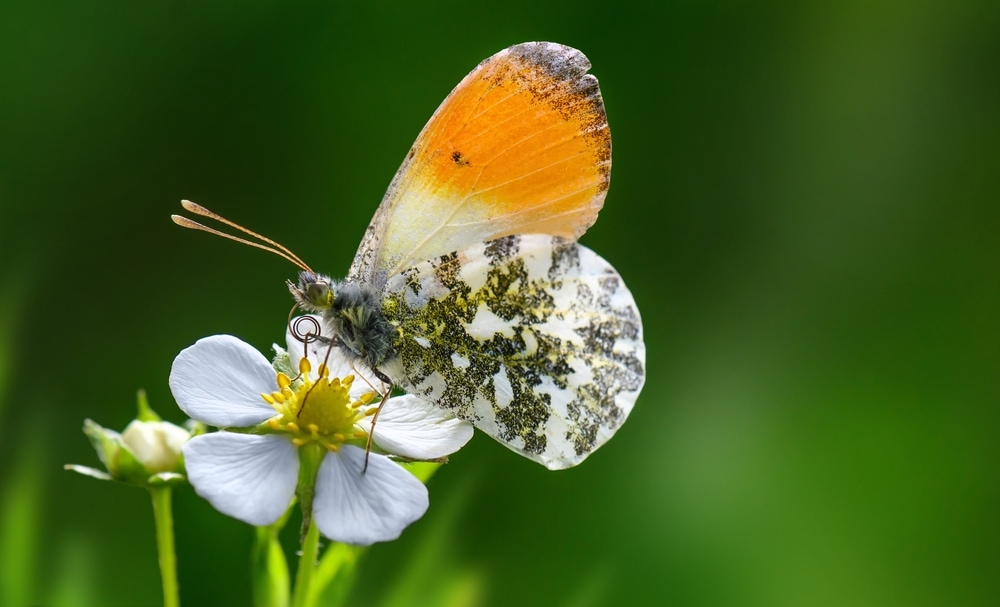
The Pieridae family is the largest family of butterflies, not the largest superfamily. They have more than 76 genera and include more than 1,100 species. Most of these live in the tropical regions of Africa and Asia. However, some varieties make their home in North America and Eurasia.
Most of the Pierid butterflies are a combination of yellow, white and orange with black spots. These pigmentations give them a distinctive appearance. Unfortunately, this family of butterflies also includes many notorious agricultural pests.
6.1 Diamorphine: Mimic Sulphurs
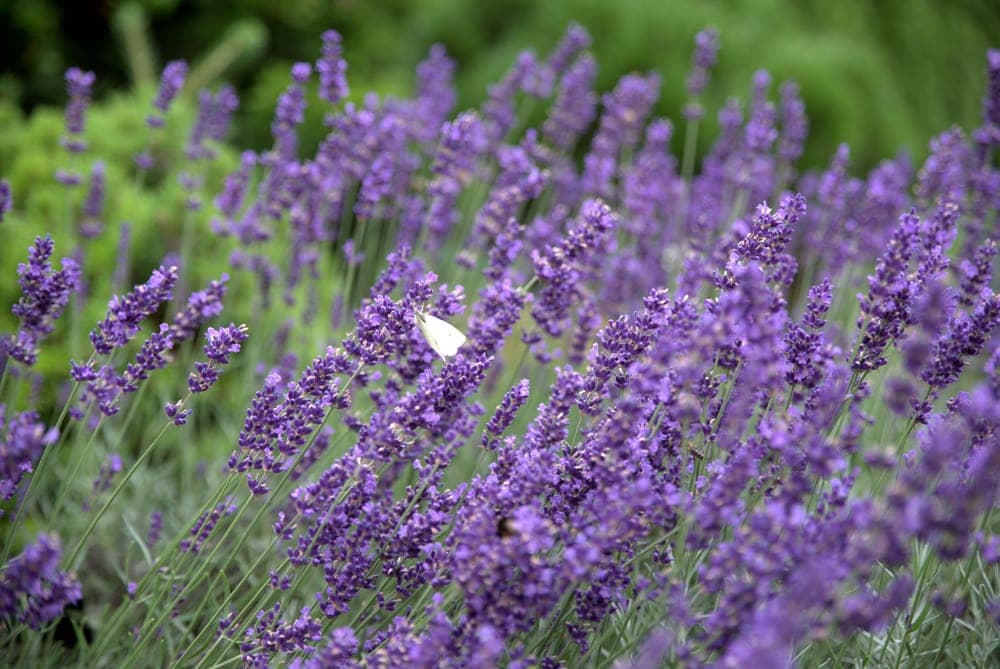
Mimic sulfurs stand out in this family since most of them don’t have the coloring typical to the family. There are about 100 species separated between seven genera. Most of these live throughout the Neotropical regions of the world. However, there is only one genus that occurs in North America, Leptidea.
6.2 Pierinae: Whites
The Pierinae is the largest subfamily in this family. They contain several clades of butterflies that many refer to as Whites. There is a range of white butterflies and those with the typical colorful display of warm reds, yellows and oranges.
6.2.1 Cabbage White (Pieris rapae)
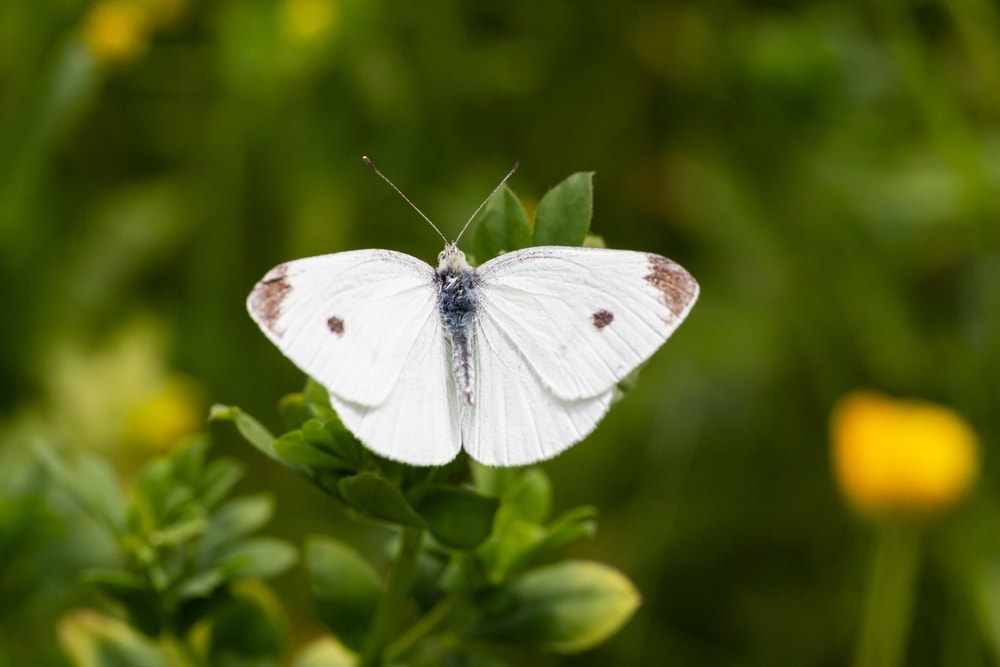
The Cabbage White is a medium-sized butterfly species that is an excellent example of white butterflies. You can find them throughout Europe, New Zealand and North America. The adult butterfly is a telltale based on the small black dots in the middle of the sea of white wings. Their bodies are often black or brown.
The caterpillar is one of the pests of many of the edible brassicas but is not a poisonous caterpillar. It is often called the imported cabbageworm. They feed on food plants like cabbage, bok choy, broccoli and kale. Many people believe the butterfly originated from the Mediterranean. However, through the past two centuries, the butterfly has spread globally. It happened because of accidental introductions.
6.3 Coliadinae: Sulphurs and Yellows
The Coliadinae family includes butterflies called sulfurs and yellows due to their color. There are about 300 species within this subfamily. About 36 species belong to this subfamily that lives in North America, ranging from Mexico to Canada.
6.3.1 Southern Dogface (Zerene cesonia)
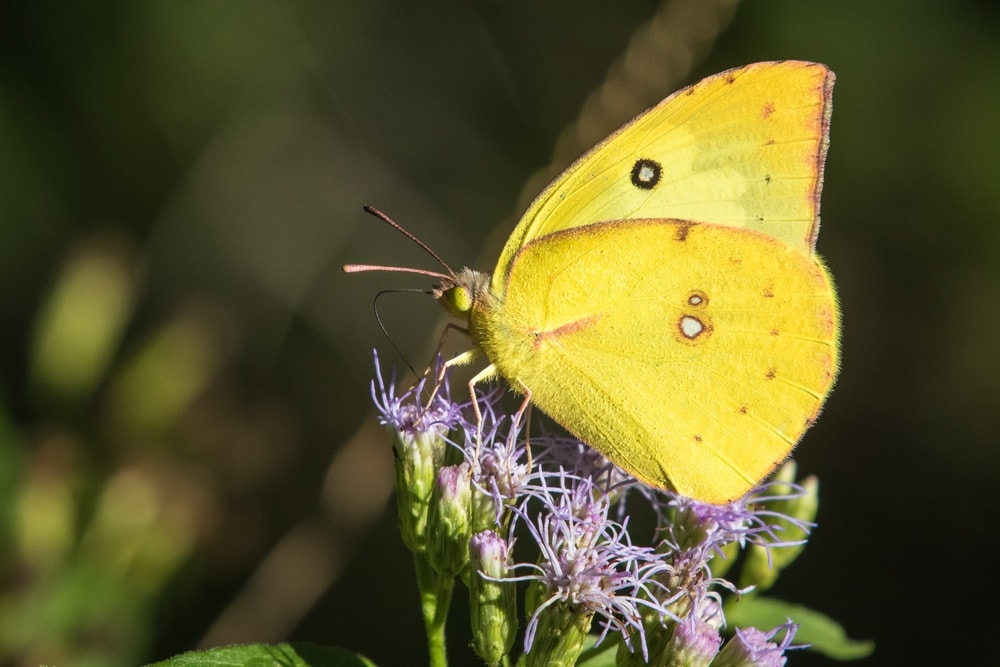
The Southern Dogface is one of the species that live in North America. They also spread down into South America. They are an excellent example of sulfurs and yellows since they have sulfur yellow wings. They have a band of black around the outside and a unique pattern on their front wings that looks like a dog’s face.
You can find these butterflies in short-grass prairie hills. They also flit near road edges and throughout open woodlands. The males are much more active than females. They patrol for females and are active flight partners.
6.4 Pseudopontiinae: Previously Monotypic Subfamily
There have recently been significant changes to this subfamily. It only includes a single genus of butterfly, which was previously monotypic. It has expanded significantly to include plenty of butterflies. They live throughout the wet forests of tropical regions in Africa. There are now at least five species of Pseudopontia butterflies.
6.4.1 Pseudopontia paradoxa
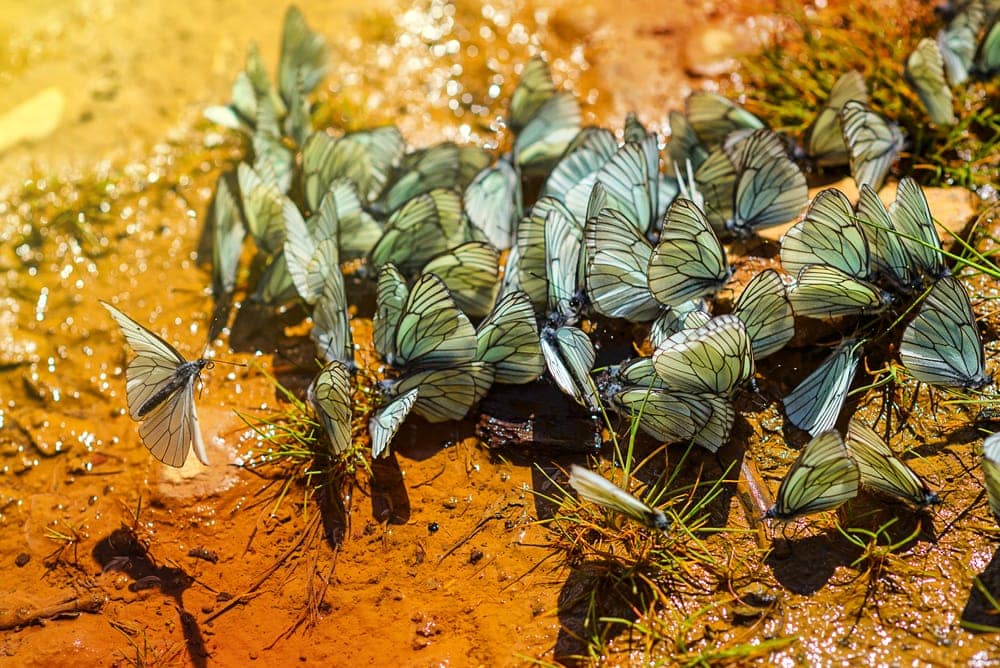
This species of butterfly lives in the tropical regions of Africa, preferring wet forestlands. They have to detail across the veins of their wings that make them quite distinguishable. Because of the remote regions in which they live, there is not much known about it.
It does have a unique factor that makes it distinguishable from other butterflies. Even though they are true butterflies, they don’t have the standard clubbed end to their antennae. Instead, they have a slight feathering.
7.0 Family Riodinidae: Metalmarks
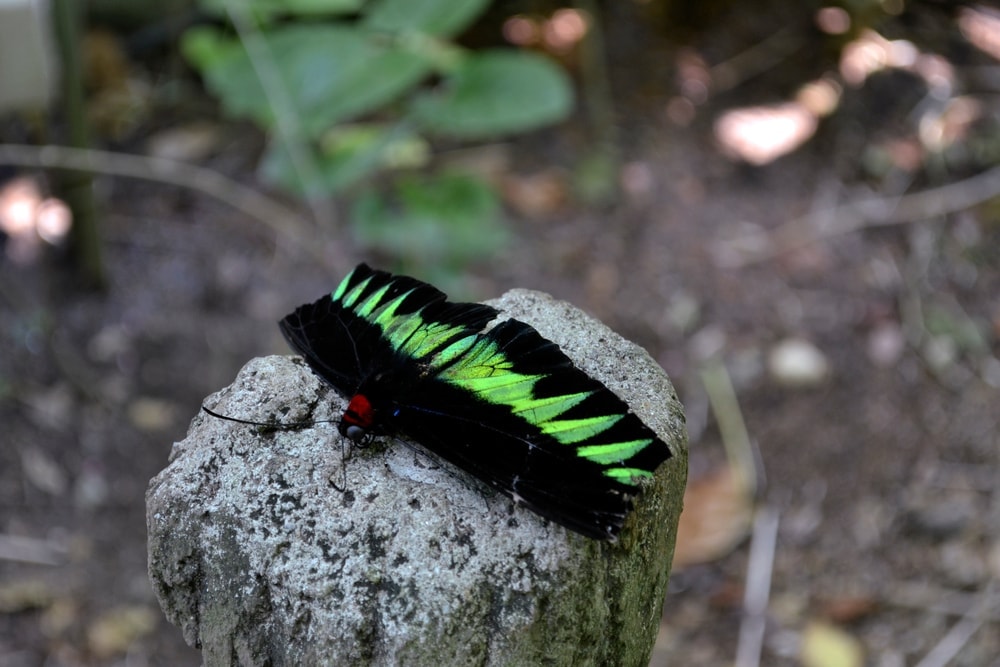
The last of the seven families of butterflies are the metalmarks. The name refers to the metallic-looking spots found on most species’ wings. There are 1,532 species divided between 146 genera in this family. Most of them live in neotropical regions of the world, but there are some in the Palearctic, Afrotropics and Australasian regions.
7.1 Nemeobiinae
The Nemeobiinae is one of two subfamilies of the metalmarks. This family consists entirely of the Old World members of the Reiodinidae family. There have only been recent revisions to the subfamily that has included some New World butterflies as well.
7.1.1 Duke of Burgundy (Hamearis lucina)
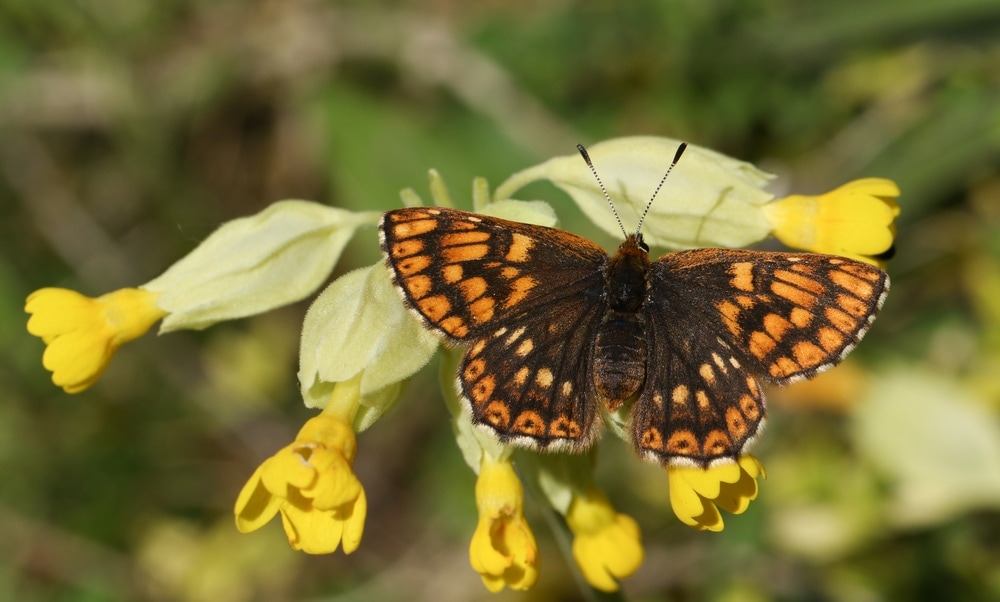
The Duke of Burgundy butterfly is the only member of the Hamearis genus. They are European butterflies. They used to have fritillary at the end of their name because of their chequered pattern. That strongly resembles the pattern of the true fritillaries that belong to the Nymphalidae family.
These butterflies have burgundy colors on their underwings with a chequered pattern of yellow, black and white. On their upper wings, they are dark burgundy with yellow and white chequering.
7.2 Riodininae
The Riodininae is the largest subfamily of metalmark butterflies. However, there is still confusion with some of the relationships of these butterflies.
7.2.1 Periander Metalmark (Rhetus periander)
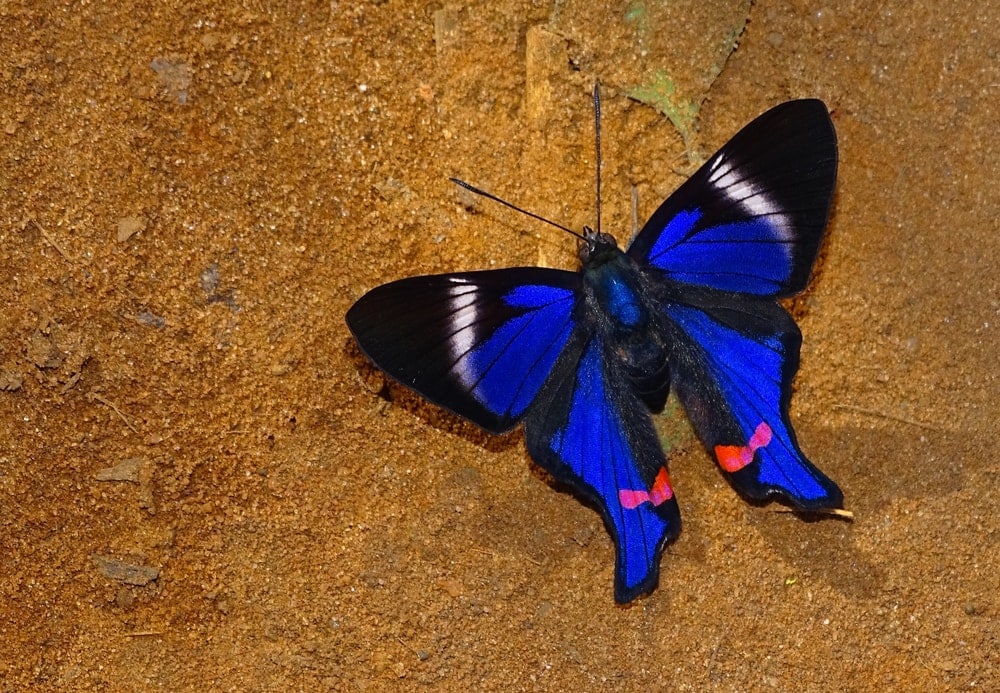
The Periander Metalmark is an excellent example of the metalloid coloration on the butterfly’s wings. They have a unique shape with pointed upper wings and slight tails on their hind wings. On the upper side of their wings, they have bright, metallic blue stripes banded by black on either side. These also include white and orange spots.
There are five subspecies of this butterfly. They are each separated by the region they live in, from Brazil to Colombia, Honduras to Costa Rica.










